-
Beam: Leading the Gaming Evolution
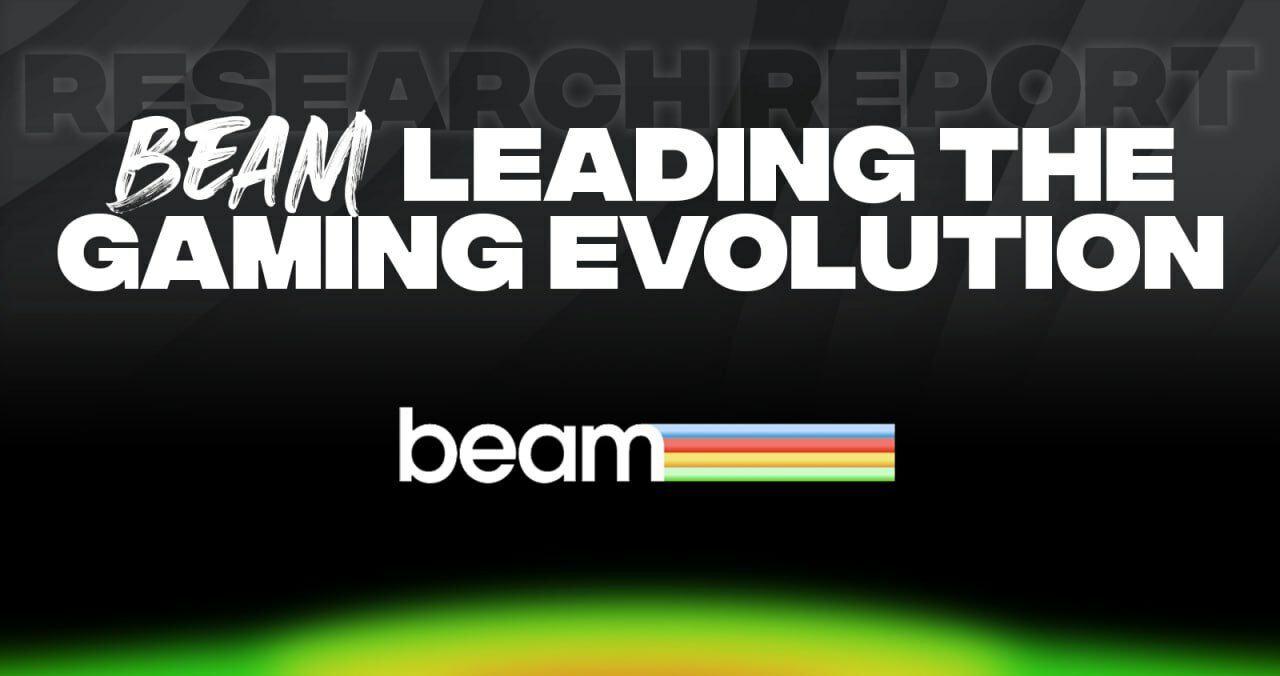

The landscape of Web3 gaming has undergone a remarkable transformation. Today we find ourselves at the stage where the underlying technology enhances rather than restricts creativity and innovation in game development, moving beyond initial experimental models like Play-to-Earn. Leading the efforts is Beam, who has taken on the responsibility of ensuring that the potential of this space can be fully realized. Blending revolutionary technology with a nostalgic feel, Beam addresses the issues that have held the space back in recent years, with every aspect of the platform designed to shift power back into the hands of the players. We will be exploring the individual components of Beam, demonstrating its commitment to bringing to life a new way of gaming.
An Introduction to Beam
Beam stands at the frontier of the gaming evolution. As a pioneering gaming blockchain leveraging Avalanche’s Subnet technology, Beam is building a platform for game developers to easily integrate the Web3 features that are revolutionizing the fundamental framework of game design. By empowering developers with a rich suite of tools, an entire ecosystem of games is taking shape on Beam, offering players a gateway into a multitude of new experiences.
The decision to utilize the Subnet design was an easy one – Subnets are one of the few solutions that offer such a high degree of flexibility whilst still being rooted to the speed and security of the Avalanche network. A sovereign blockchain allows the freedom to choose your own native gas token, a customized validator set to ensure regulatory or hardware requirements are met and of course, private blockspace. Crucially, with Avalanche’s consensus mechanism, it achieves sub-second finality – a vital component to the gaming industry where high throughput and low latency are key requirements.
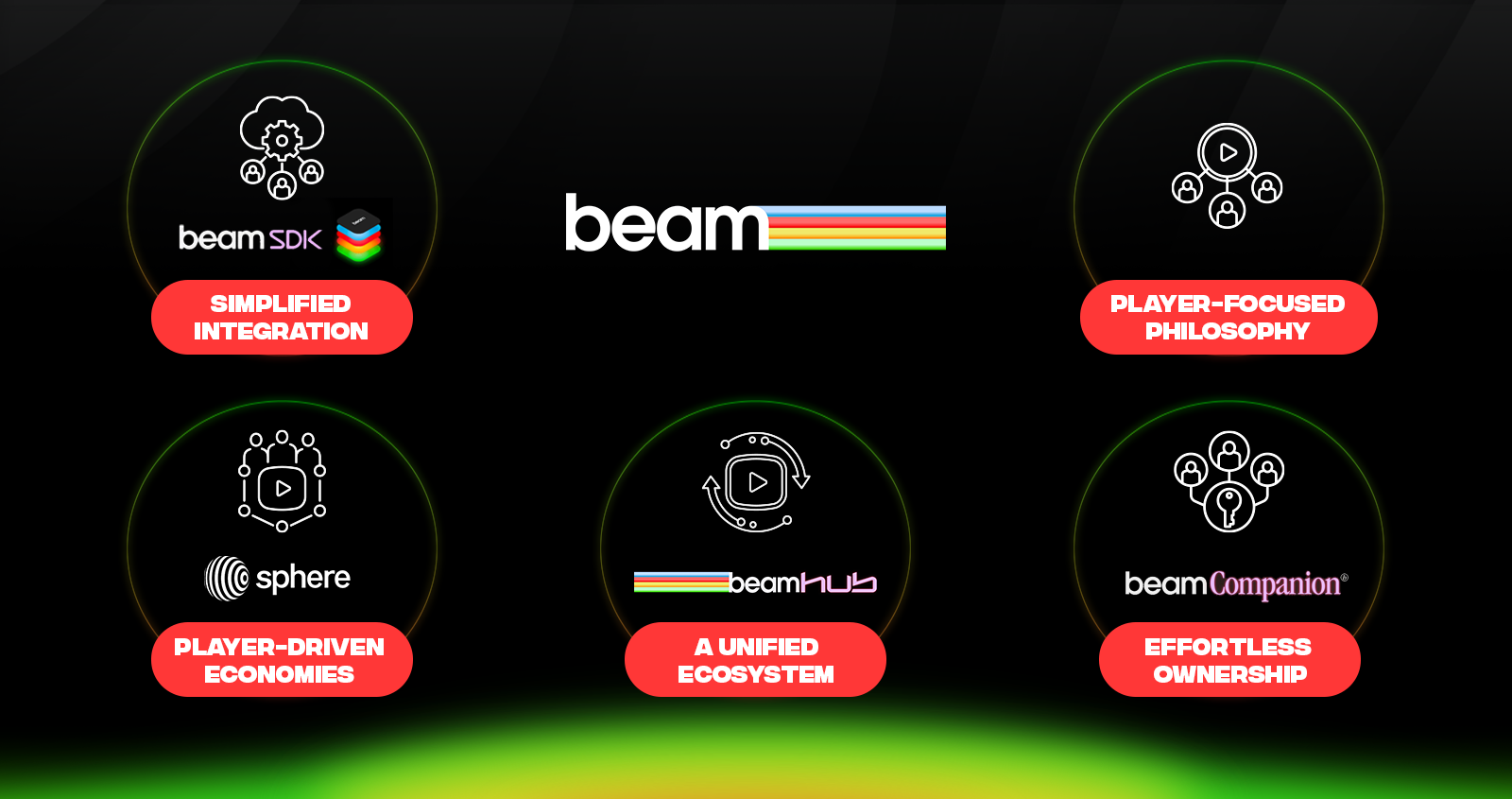
Merit Circle DAO: A Collaborative Force Behind Beam
Beam aims to offer the most powerful set of gaming-focused tools as well as an ecosystem for a passionate community to come together and foster growth. But above all, games building on Beam have the opportunity to collaborate and tap into the expertise of Merit Circle DAO, a leader in the Web3 gaming industry.
Since its original roots as an Axie Infinity guild, bringing together an entire network of players from across the world, Merit Circle has not only experienced first-hand, but has also been a key contributor to the Web3 gaming evolution. Throughout this journey, they have gained a profound understanding of the industry’s missing pieces and what it will take to usher in a new era of gaming, which has resulted in the creation of Beam. Few teams possess the extensive knowledge of the gaming space that Merit Circle has, along with their deep commitment in pushing the industry forward.
A Player-Focused Philosophy
The core philosophy of Beam is to empower players with new gaming experiences that allow levels of ownership that have simply not been possible in traditional game design. They also understand that this may not be for everyone, which is why Beam has removed all blockchain complexities for the average player. However, it simultaneously caters to those who do want to take ownership of their in-game assets. This flexibility to opt-in for ownership is perhaps what makes Beam’s approach so effective, striking a unique balance between innovation and accessibility.
Beam has a crystal clear vision: to give power back to the players by simplifying Web3-enabled game development and accelerating the next generation of games being built. With an entire library of games already integrating with the network, Beam is a testament to how far the gaming industry has come through the impact of blockchain technology.
How Beam is Reshaping the Future of Gaming
Beam has been carefully designed to give players a superior gaming experience that expertly merges Web3’s capabilities with uninterrupted gameplay. Every element of Beam embodies this philosophy, ensuring that all players can benefit from this revolutionary era in gaming.
Effortless Ownership
Blockchain technology has redefined the concept of ownership in gaming and with it, what players should expect from the hours they put into a game. Beam’s Companion App allows players to easily link their in-game profile to set up an account which gives them full ownership of their in-game items. Working with OpenFort to leverage Account Abstraction, a player can setup an account with their chosen social login in seconds. Their private key is securely encrypted into their device so that there is no need to worry about any recovery phrases. This simple flow addresses one of the biggest challenges that has been holding the space back, preventing adoption from millions of traditional gamers.
By giving players the option to take ownership only if they choose to, Beam empowers them to simply enjoy the gameplay without ever having to deal with the blockchain layer. For experienced Web3 gamers or those who want to explore the ownership aspect, the Companion App can be used to swap assets, send in-game items to friends or lock up their items in a secure vault. This level of flexibility also allows players to unlock true ownership only when they feel it is worthwhile.
The Companion App showcases Beam’s dedication to building an inclusive blockchain-powered platform. It offers a versatile and robust solution, designed to meet the diverse needs of all players on Beam.
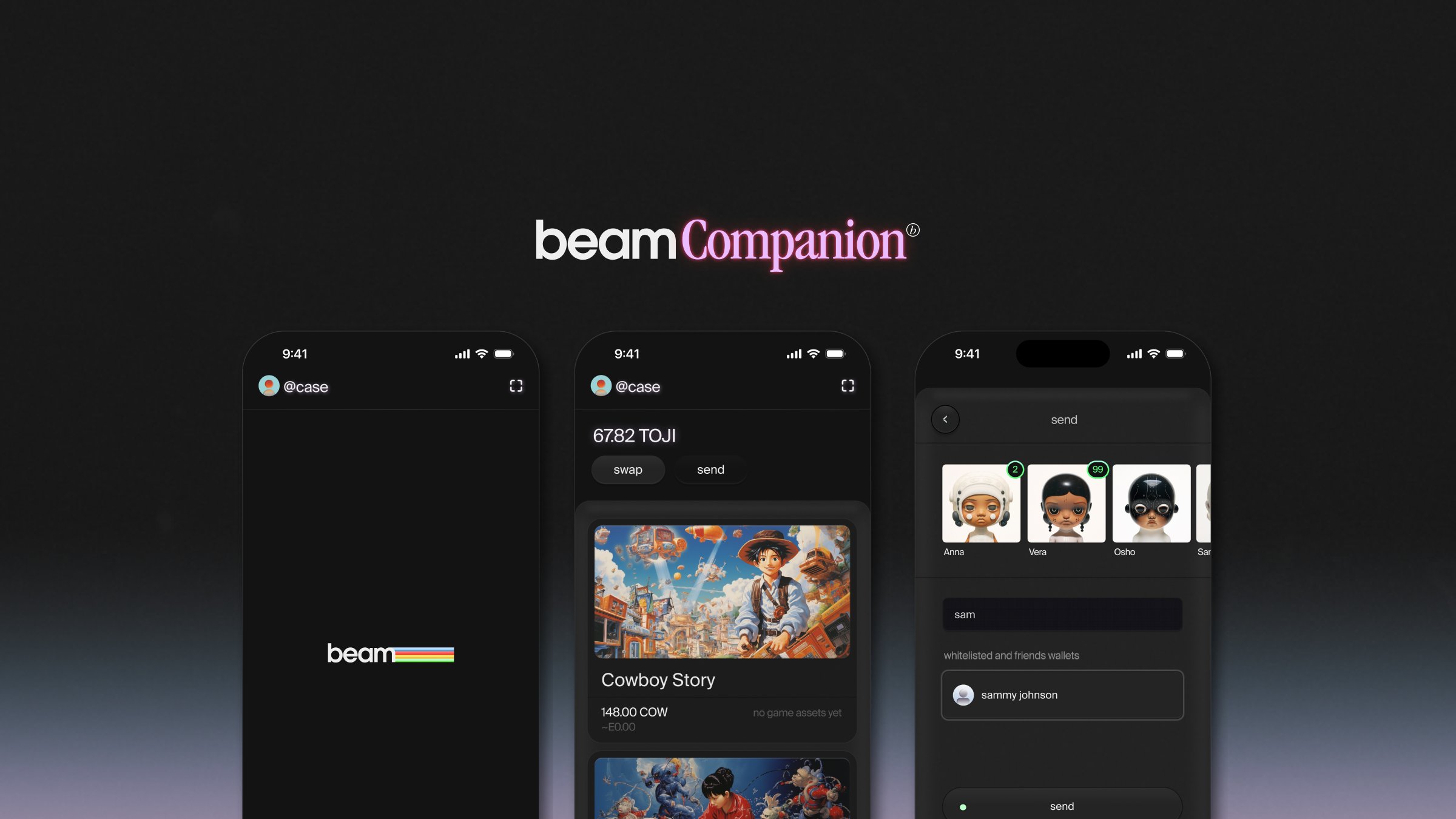
Source: @BuildonBeam Player-Driven Economies
The industry’s shift away from the Play-to-Earn model has brought into focus a key element that is lacking in traditional games: the ability to freely trade digital assets which hold real value. Before the integration of blockchain infrastructure, players faced very fragmented and limited ways of trading their assets. There was no true ownership involved as these items technically belonged to the game studio and there was no reliable way of verifying the authenticity of an item.
As digital items found their space in the Web3 landscape, multitudes of NFT marketplaces have appeared but none have focused solely on gaming. Merit Circle took this problem into their own hands and have built Sphere – a marketplace built specifically for trading gaming assets. Although it can act as a standalone marketplace, Sphere’s primary role is to enable games to easily build their own in-game marketplace which uses Sphere’s API as its foundation.
At Beam, transparency is one of the core values. Unlike many other platforms, Sphere will include information that is important to gamers – such as the context of the rarity of an item and its actual utility within the game. These are small but essential details to enhancing the gaming experience, which have often been overlooked. Sphere’s design is centered around a seamless user experience and aims to offer the premier solution to facilitating player-driven economies.
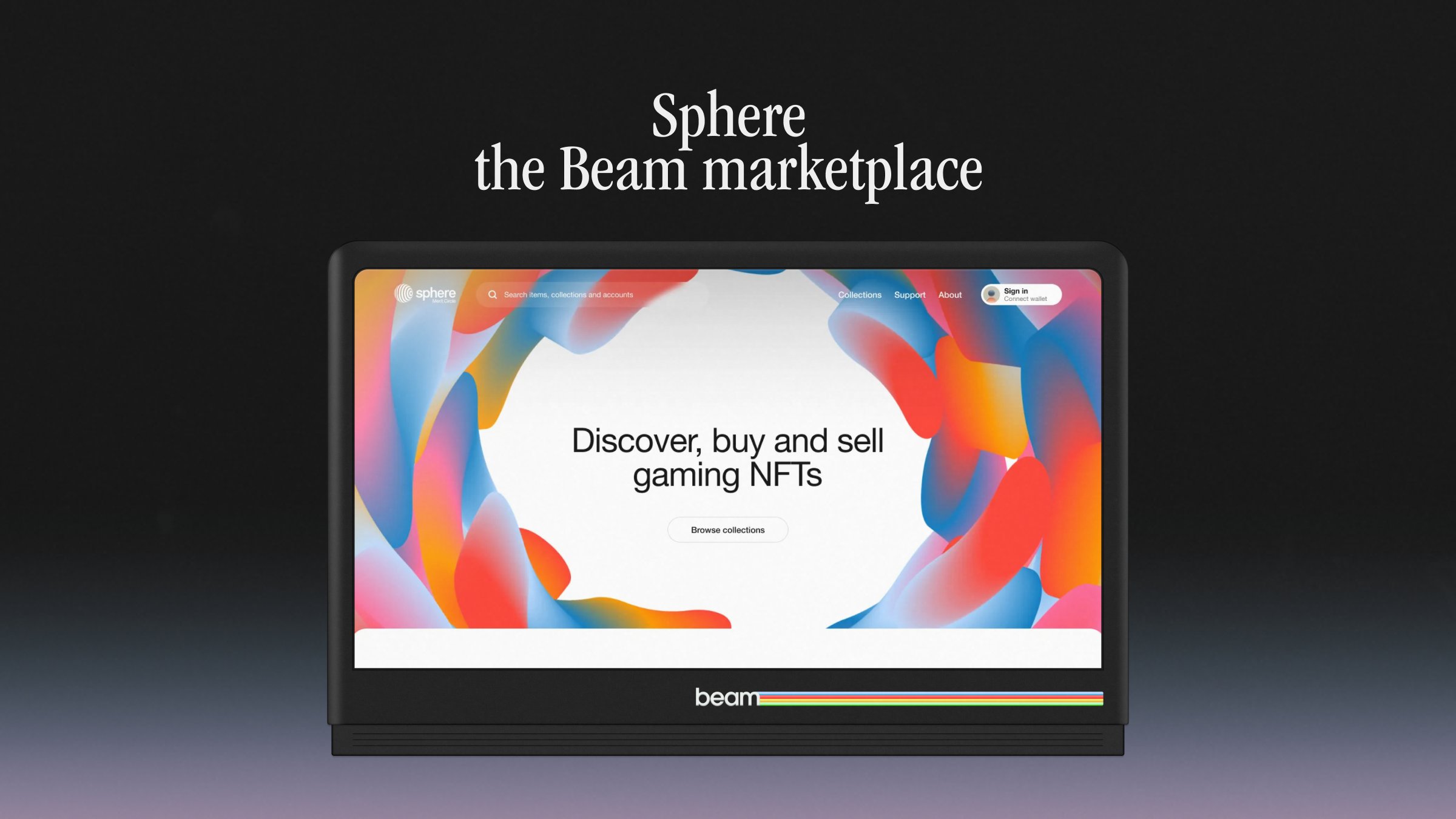
Source: @BuildonBeam Simplified Integration
To best serve the players, Beam first has to provide game developers with the tools needed to build the most fun and engaging experiences. Beam SDK acts as the invisible link for builders to seamlessly integrate their game to the Beam Network and leverage blockchain’s capabilities. It has been created to allow developers to focus on the creativity of game development and not have to worry about the complexities of blockchain integration. At its core, the Beam SDK is a flexible tool that gives developers the power to maintain control over their game design throughout the development process. By utilizing Beam SDK, developers gain access to the innovative possibilities offered by the Beam Network, enhancing the overall gaming experience without compromising their creative vision.
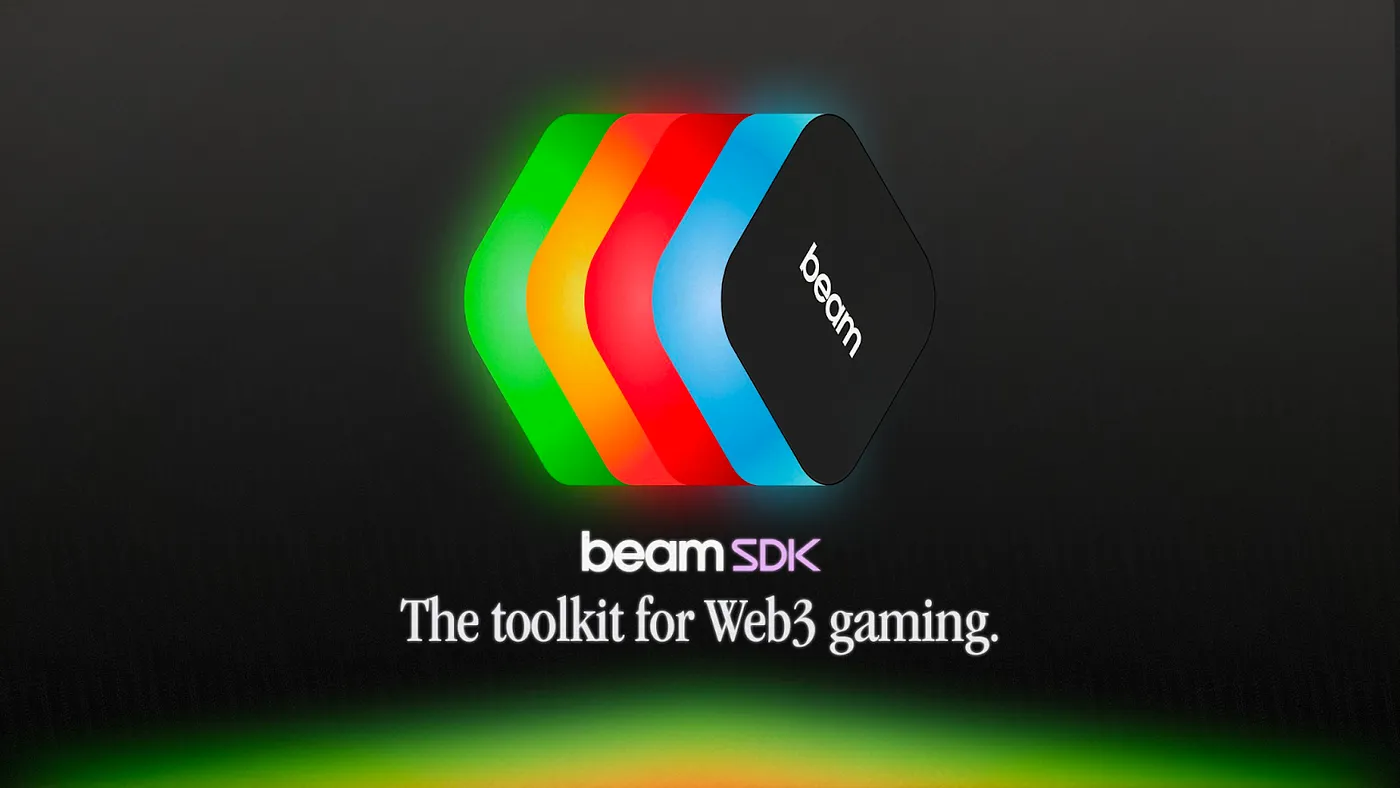
Source: @BuildonBeam A Unified Ecosystem
Beam’s core mission is to foster an ecosystem that unites passionate gamers and developers, driving the advancement of Web3 gaming into the mainstream. Beam Hub acts as the home of the Beam ecosystem, where players can come to discover new experiences, rate and review games and connect with other players. Its thoughtful design caters to two key audiences – early access players and competitive players, making Beam a truly universal platform. Because at Beam, the voice of the player matters and building a strong player-first community is central to its vision. Beam Hub is not only a place for discovery but empowers players to actively participate in the development and evolution of their favourite games.
As Beam’s product suite grows, BeamOS is where you can discover every tool and feature built on Beam.
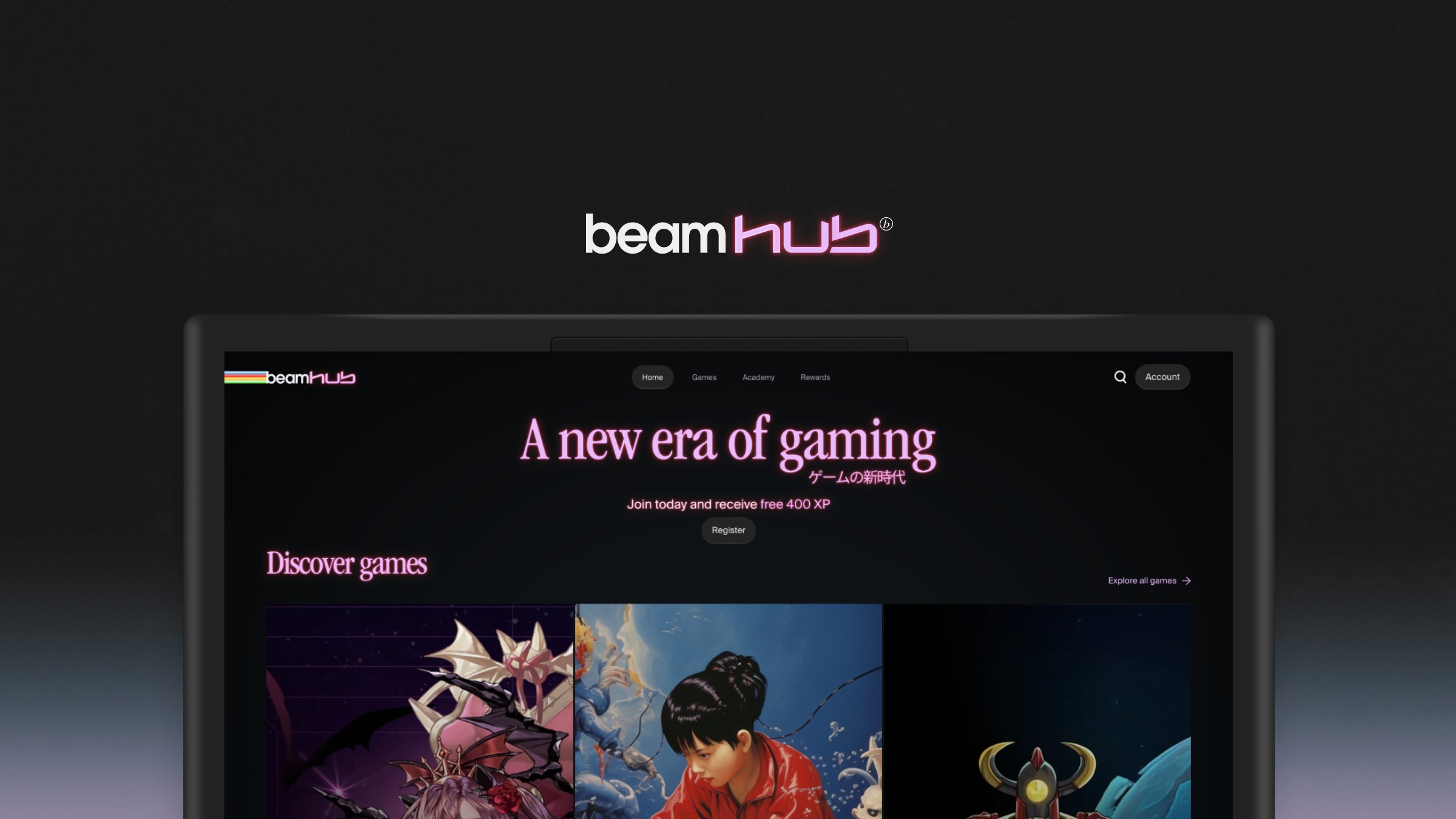
Source: @BuildOnBeam The Beam Expansion
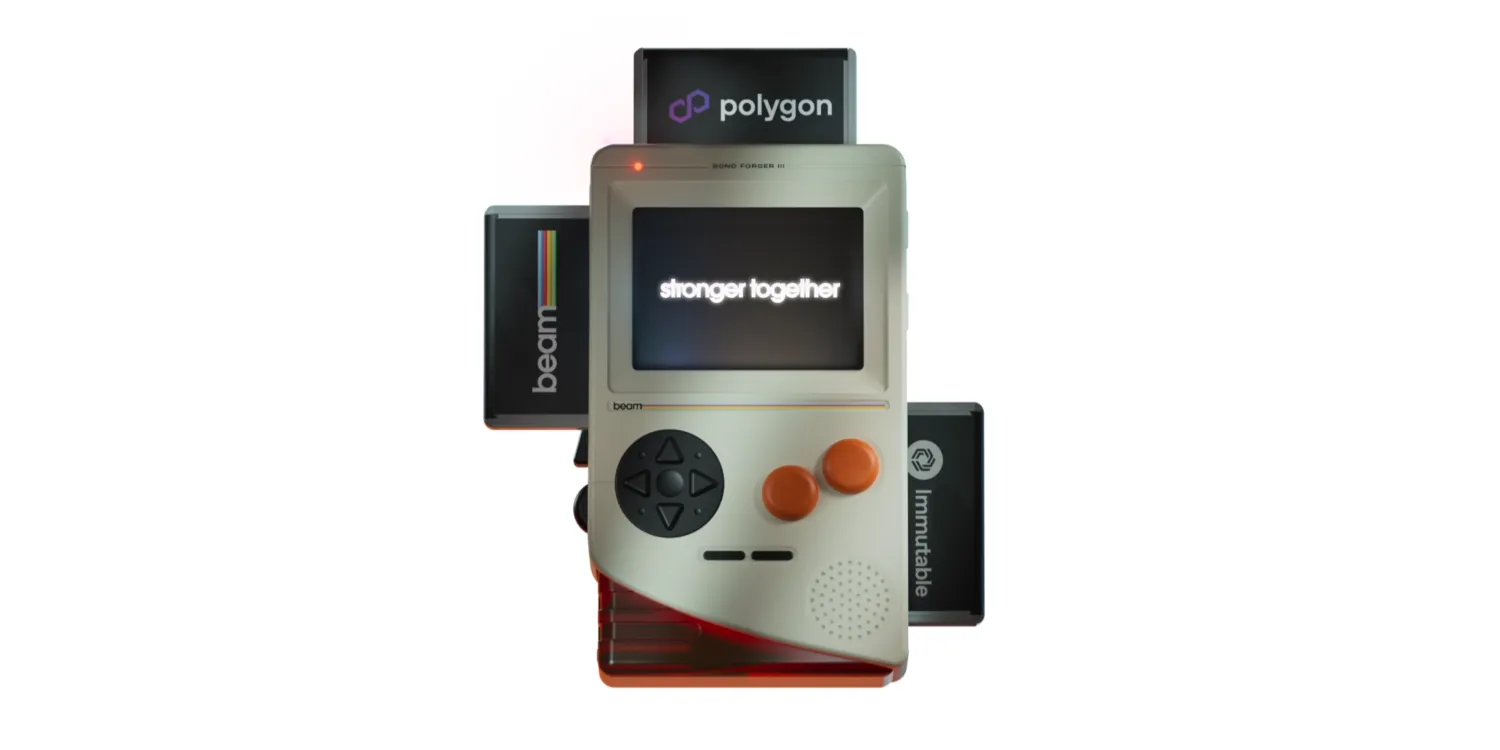
Source: @BuildOnBeam Launching as an Avalanche Subnet was the first step in Beam’s vision of evolving into a chain-agnostic gaming hub. Beam has recently announced that it will be joining forces with the Immutable zkEVM, powered by Polygon. This collaboration will kick off with two major developments: the launch of the Sphere marketplace on Immutable and the integration of the Immutable Passport into Beam’s Companion App. This is a significant step in making Sphere the go-to marketplace for all games.
Through Beam, we are witnessing the largest names in Web3 gaming working together to unlock the most powerful gaming infrastructure. In doing so, this will accelerate Web3 game development and create an even more enriching gaming experience. Beam’s commitment to becoming chain agnostic will enable it to reach players from all corners of the gaming landscape.
The BEAM Token
With the launch of Beam and the approvals of MIP-28 and MIP-29, the Merit Circle token ($MC) has now migrated to the $BEAM token. BEAM has several built-in utilities which include:
- Delegation – BEAM holders will be able to participate in securing the network by delegating their tokens to a Beam Validator.
- Governance – Participate in the governance of the Merit Circle DAO.
- Gas Token – Every transaction on Beam will require BEAM to be paid as gas, with part of this fee distributed to validators and another portion burned.
- Validation – Secure the network by running a Beam validator node and receive BEAM rewards.
- Buyback & Burn – As part of MIP-7, which ensures that the Merit Circle DAO maintains a self-sustaining system, 15% of the DAO’s investment proceeds will be used to buyback & burn BEAM to decrease its supply.
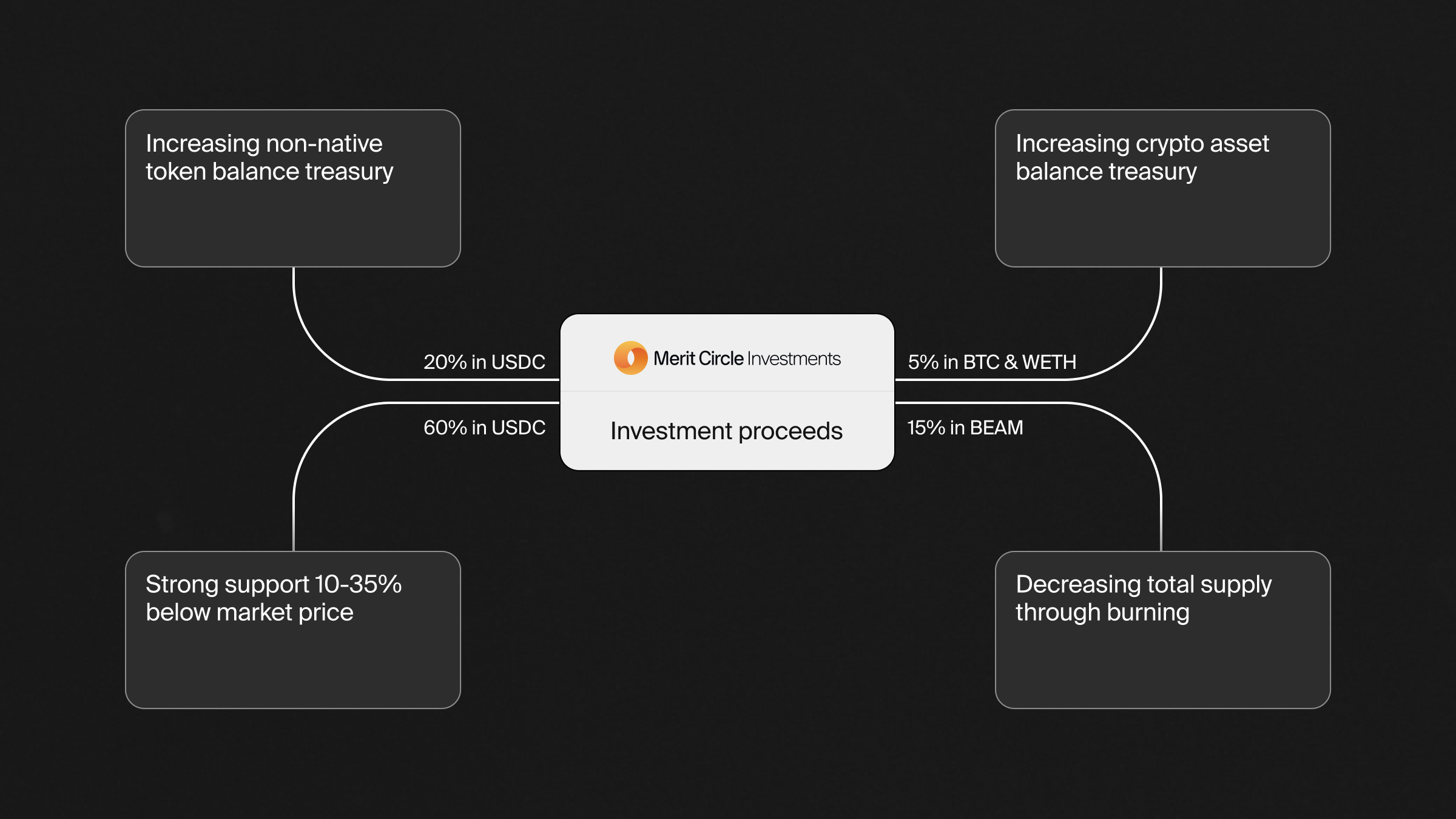
Merit Circle DAO’s MIP-7 Proposal Beam Spotlight
City of Greed
“Mastermind your strategy, accumulate resources, and triumph over escalating land taxes as you navigate this dynamic blend of Roguelike, Resource Management, and Deck-building.”
Megaweapon
“Prepare for an action-packed gaming experience in the fast-paced, top-down shooter world of Megaweapon, featuring various avatars, game modes, and maps to explore!”
Raini: The Lords of Light
“A card game set in the fantasy world of Rainiverse where players have to strategically manage an army of creatures to defeat the main enemy, Quantum Rug.”
🕹️ Play Raini: The Lords of Light
Castle of Blackwater
“Experience the mysterious fantastical 2D social deduction game with Castle of Blackwater, where players can play different roles, scout the village, and finish quests.”
Explore and keep updated with all the new games building on Beam.
Conclusion
Although Beam’s journey has just begun, it represents a monumental force in the gaming industry, bringing together the expertise of Merit Circle, the powerful engine of Avalanche technology and deep industry partnerships such as Immutable and Polygon. In the search for the perfect balance between Web3 features and enhanced creativity in game design, we are finally seeing this vision come together. Players’ growing desire for ownership and agency in their gaming experience is central to Beam’s philosophy. The platform’s unique approach of allowing players to opt-in to the ownership element, while simultaneously abstracting the complexities of crypto, is pivotal in attracting a broader audience. Beam is dedicated to solving two fundamental challenges – streamlining the on-chain experience for players and simplifying all blockchain elements for developers.
However, Beam is much more than just a place to have fun, it’s a platform where communities can come together to create meaningful experiences whilst pushing the technological boundaries of innovation. The ultimate goal is to bring these dynamic experiences to a global audience. Beam’s ecosystem represents a significant leap forward in the gaming industry, where player engagement and cutting-edge game development converge to make way for the next generation of gaming.

-
Tokenization on Avalanche


The Rise of Tokenization: Understanding its Importance
In recent months, the tokenization of real-world assets (RWAs) the blockchain ecosystem. Tokenization is the process of converting the rights to an asset—whether tangible or intangible—into a digital token on a blockchain.
These on-chain tokens act as a digital representation of ownership, encapsulating the value and rights associated with a physical or digital asset. This transformation is facilitated through the use of smart contracts – enabling the entire process to be seamlessly automated.
In contrast to traditional systems, tokenization allows transparent and secure issuance, along with efficient management of these digital assets, therefore overcoming the inherent limitations and inefficiencies of current frameworks.
This powerful use case of blockchain technology has found a compelling synergy with the values of DeFi – creating a unique opportunity which significantly amplifies their combined impact on the financial system. By combining the virtues of DeFi with the tokenization of RWAs, we now have the ability to source more stable collateral. This not only results in more sustainable yield and diversified risk for these protocols, but also solidifies DeFi’s inevitable position within the broader financial landscape. As DeFi continues to innovate towards a transparent, open economy, tokenization stands at the forefront as an instrumental tool, providing a clear and direct path to this ambitious goal.
It’s important to note that tokenization does much more than merely streamline the financial system – it has the potential to revolutionize the global economy on a fundamental level. It realistically enables a future where opportunities are democratized and legacy systems are reconfigured to push forward a new era in the evolution of humanity. By tokenizing RWAs, we are actively enabling global, inclusive participation in wealth creation, thereby transforming the economy and laying the groundwork for a fairer world.
The Tokenization Market Outlook
Leading institutions are viewing tokenization as a trillion dollar market opportunity due to its ability to unlock the liquidity of currently illiquid assets – primarily in the private capital markets. Boston Consulting Group projects that, as a conservative estimate, the global market for tokenized illiquid assets could reach $16 trillion by 2030. However, on the higher end of the projection, the market has the potential to reach an astounding $68 trillion.
Considering the exponential scale of the tokenization market, an increasing number of leading financial institutions are recognizing the magnitude of its potential. In this sector alone, tokenization is firmly positioning itself as the catalyst for widespread adoption of blockchain technology.

What is being tokenized?
Whilst financial instruments are leading the way, there is a wide spectrum of traditional assets that can be tokenized:
- Traditional financial instruments
- Securities – This broad category includes equity securities (stocks), debt securities (bonds), derivatives and various types of investment funds.
- Structured Investment Products – Complex financial instruments crafted from multiple underlying assets like bonds, commodities, currencies, equities or mortgages. They strategically combine various elements from securities and derivatives to tailor risk and return profiles.
- Private equity – Involves investments in private companies – typically reserved for high-net-worth individuals (HNWIs) and investment funds.
- FX Market – Includes all currencies that are traded internationally.
- Derivatives – Financial contracts whose value depends on an underlying asset – can include futures, options and swaps.
- Commodities
- Insurance
- Intellectual Property
- Real Estate
- Wine, Fine Art, Luxury goods and other rare collectibles

The Transformative Potential of Blockchain
For Investors
- Democratized access – Tokenization facilitates asset fractionalization, which substantially broadens market participation – especially in private markets and structured investment products, which are historically reserved for HNWIs. The significantly reduced operational costs for issuers also enables smaller investment minimums, further empowering retail investors.
- Ownership rights – Blockchain provides a secure ledger where each token represents a stake in an underlying asset. This immutable record ensures that the investors’ ownership rights are not just recognized, but also easily transferable – making the investment process much more flexible.
- Transparency & security – On the security layer, blockchain’s immutability ensures accurate and transparent records, giving investors peace of mind and greater confidence in their on-chain investments.
- Efficiency – Automation via smart contracts streamlines the distribution of payouts, dividends and interest, making the investment process more effortless and efficient.
For Issuers
- Increased liquidity – The ability to fractionalize assets plays a huge role in unlocking liquidity across various markets. Bain Capital estimates that private assets outside the financial system are worth around $540 trillion – a large amount of which face liquidity challenges. Tokenization is emerging as an effective solution in unlocking value and providing easier access to capital for traditionally illiquid assets.
- Real-time settlement – Unlike traditional systems, where settlement can take days, blockchain facilitates near-instant settlement, thus eliminating counterparty risk and transforming the investment workflow.
- Operational efficiency – Manually-intensive operations can be automated via smart contracts. Boston Consulting Group reports that asset tokenization could save $20 billion in global clearing and settlement costs alone.
- Regulatory compliance – Subnet technology on Avalanche provides issuers with the ability to create customized blockchains that can be easily configured to meet compliance laws of any part of the world they operate in.
Interoperability – powering innovation
Interoperability, one of the key virtues of blockchain technology, serves as a powerful catalyst for innovation, enabling seamless composability between applications.
For investors, this unlocks an increased number of investment opportunities, which further diversifies their portfolio. Meanwhile, for issuers, it allows them to leverage the benefits of interconnected applications, expanding their reach to a broader number of market participants.
Interoperability plays an important role in cultivating a more inclusive and connected ecosystem across various industries, allowing for capabilities beyond the restrictions of legacy infrastructure.
The Tokenization Landscape on Avalanche
Avalanche’s dynamic Subnet technology is empowering institutions and traditional companies across industries. Leveraging their customizable features, these companies are not only seamlessly transitioning their existing offerings on-chain but also introducing new innovative tokenized products. Here’s an overview of 9 tokenized products being built exclusively on Avalanche:
Financial Services
Securitize & KKR
Securitize, an industry-leading tokenization platform, has been instrumental in driving accessibility to the private markets through compliant tokenization. In September 2022, they collaborated with prominent global asset manager, KKR, to provide tokenized exposure on Avalanche to KKR’s healthcare fund, typically reserved for HNWIs. This pioneering effort signified a major advancement in Avalanche’s objective to digitize RWAs.
Further pushing market transformation, in July 2023, Securitize initiated the offering of tokenized shares in a Spanish real estate investment fund, specializing in commercial healthcare real estate. Securitize is the first to offer such digital asset securities under the EU’s new pilot regime for digital assets.
Intain
As part of Avalanche’s Evergreen initiative, Intain was one of the first structured financial services to build a Subnet with IntainMARKETS – a tokenized marketplace for asset-backed securities. Intain leverages automation and blockchain transparency for operational efficiency, enabling real-time investor reporting and swift payouts. This increased efficiency means a reduction in costs, which in turn allows for lower investment minimums, broadening the reach of their structured investment products.
By unifying all trust intermediaries onto a single platform for its administration services, Intain showcases blockchain’s ability to substantially streamline the entire deal structure process.
DEFYCA
Digital securities firm, DEFYCA, is building a tokenized private credit protocol that aims to open up investment opportunities in the private markets. Utilizing blockchain technology, DEFYCA is the first company to offer tokenized securities to professional investors under the EU’s upcoming cryptocurrency regulatory framework – MiCA.
In traditional systems, debt issuance is a manually-intensive operation, which involves liability matching, settlement, payment flows and price discovery. DEFYCA automates these steps through smart contracts, greatly improving administrative efficiency.
AmFi
AmFi is a financing platform that combines traditional financial products with blockchain’s efficiencies, enabling companies to easily set up and manage real-world credit solutions through automated processes. Its first product, AmFi Liquidity Pools, allow established financial services to create Funding Pools that are collateralized with tokenized RWAs. These Liquidity Pools faciliate funding for businesses whilst offering innovative products to investors. AmFi’s current focus is on democratizing access to capital for smaller businesses in Latin America.
INX
INX, an SEC-registered platform, facilitates compliant trading and investment in both cryptocurrency and security tokens. INX also helps companies raise capital through the issuance of digital securities and in doing so, provides unique investment opportunities. As part of its services, INX offers a comprehensive solution for issuing SEC-compliant digital securities, from token modelling and smart contract deployment to management of the token’s lifecycle.
INX works closely with regulators to ensure compliance, actively contributing to the development of regulatory frameworks in the digital asset industry.
HiYield
As part of Avalanche Vista’s initial cohort, HiYield is developing a user-friendly platform that aims to consolidate the global on-chain capital markets. The platform provides investors with an expanding set of strategies designed to generate sustainable yields across a diverse range of institutional-grade asset classes.
HiYield is building towards a more inclusive financial system powered by blockchain technology. It aims to offer features such as fractional ownership, enhanced liquidity & accessibility, peer-to-peer lending & borrowing, and interest earning opportunities.
Cables
Cables is innovating in the tokenization space by integrating blockchain settlement technlogy into the FX industry – establishing itself as one of the first protocols to focus on this sector of the market. A self-custody DEX built on Avalanche, Cables is focusing on stablecoin and cross-chain pairs. The platform’s mission is to incorporate blockchain rails into the FX market as well as bringing FX derivatives to the stablecoin market. This unique approach gives both institutional and retail investors access to transparent pricing and unified liquidity, all within a non-custodial framework.
Insurance Services
Re
Re’s vision is to streamline the process of connecting capital in the nearly $1 trillion reinsurance market, increasing accessibility to this traditionally ambiguous asset class. Simply put, reinsurance is ‘insurance for insurance companies’ – it allows insurers to transfer their risk to a reinsurance company. This ensures that they can maintain a healthy balance sheet to allow for seamless payouts when claims are made.
The Re protocol gives accredited investors the opportunity to provide backing for real-world insurance policies and companies across a variety of risk portfolios. To achieve this, Re is building a dual product model on Avalanche. This involves the main dApp that lives on the Primary Network and a Subnet designed to store all private information – demonstrating the versatile use cases of Avalanche Subnets.
By leveraging blockchain’s transparency and speed, Re not only offers a superior experience to insurers, reinsurers and policyholders, but also expands opportunities for participation in the reinsurance market.
Lemonade
In March 2022, digital insurance company, Lemonade, made a significant move into the blockchain industry. They launched an initiative to protect African smallholder farmers from climate change risks by offering permissionless on-chain insurance. Built on Avalanche, the offering is one of the first projects by the Lemonade Crypto Climate Coalition, a DAO funded by the Lemonade Foundation.
The project addresses a pressing issue facing 300 million smallholder farmers in Africa, who largely lack protection against climate-related risks. Their dependence on rainfall for crop growth is increasingly challenged by environmental conditions such as drought, which can have serious impacts on their livelihoods. Traditional weather insurance is usually unavailable or expensive in these regions due to high operational costs and inaccurate weather data.
Lemonade’s innovative solution leverages smart contracts for policy management and automatic claim payouts, combined with Chainlink oracles for real-time weather tracking. With the huge reduction in backend costs, Lemonade is able to offer affordable insurance to farmers. Insurance capacity is provided through on-chain capital pools, which offer investors an opportunity to participate and receive a share of the farmers’ premiums. This transparent and efficient process eliminates counterparty disputes and streamlines the payout process, effectively delivering much-needed insurance services to emerging markets.
Lemonade’s pioneering efforts signifies an important milestone, showcasing the potential of blockchain technology as a solution to global challenges.
Avalanche Vista – Fueling Tokenization
In July 2023, the Avalanche Foundation announced the launch of Avalanche Vista – a $50 million initiative dedicated to propelling tokenization innovation on Avalanche. The initiative aims to accelerate innovative tokenization efforts, by using the alloc ated funds to purchase tokenized assets and support teams that are making significant developments in the tokenization space.
Avalanche Vista marks a pivotal moment in Avalanche’s journey, underlining their firm commitment to redefine traditional systems. By digitizing RWAs, Avalanche is playing a major role in democratizing access to investment opportunities, particularly within the historically-exclusive private markets.
Conclusion
The current financial system is undergoing a profound transformation, deeply intertwined with the rise of tokenization. As we tokenize RWAs, we are witnessing the reshaping of a global economy, through the convergence of traditional finance and DeFi. This unification is empowering the blockchain industry as a whole to demonstrate real change in creating a more inclusive financial landscape. The exponential impact of tokenization is gaining momentum and recognition across all sectors, evident in the surge of tokenized products in the ecosystem.
The potential of blockchain is no longer just an abstract vision – it’s a tangible reality being materialized on Avalanche today. As a leading player in this paradigm shift, Avalanche’s unique features and dedication to driving change provide a powerful framework in revolutionizing our global infrastructure.

- Traditional financial instruments
-
BTC.b – A Powerful Catalyst for the On-Chain Financial Revolution


The Blockchain Evolution
Since the creation of Bitcoin in 2009, blockchain technology has evolved through three significant generations. Bitcoin first revolutionized financial transactions on a global ledger, eliminating the need for trusted intermediaries. Ethereum, the second generation, expanded blockchain’s scope with smart contracts, which allowed the creation of decentralized applications (DApps) and what we now know as DeFi. However, as the user base grew, so did the demand for improved scalability. Avalanche, a third generation blockchain, has dramatically redefined a blockchain’s fundamental capabilities, establishing the foundations for an interconnected global landscape, specifically engineered for sophisticated, impactful applications.
BTC.b – Unifying the Three Generations of Blockchain
To bring us full circle, we have BTC.b – a native representation of Bitcoin on the Avalanche network. BTC.b retains Satoshi’s foundational principle of being a decentralized value transfer, while simultaneously expanding its functionality to actively participate in Avalanche’s rich DeFi ecosystem. By unifying the three generations of blockchain development, BTC.b democratizes access to new opportunities for both individual investors and traditional institutions alike. Moving beyond the traditional perception of Bitcoin as merely ‘digital gold’, the integration of BTC.b into the DeFi ecosystem not only taps into its $500B market cap (at the time of writing) but also further revolutionizes its potential as an asset class.

Understanding BTC.b – What sets it apart from WBTC?
BTC.b is a native ERC-20 token on Avalanche that represents Bitcoin bridged from the Bitcoin network, which can then be used across the ecosystem in yield-generating strategies.
It provides a superior alternative to WBTC, by eliminating the inherent risk associated with its reliance on third party custodians. WBTC requires the user to submit a request to a merchant, who then interacts with a custodian – who is responsible for executing the minting and redeeming of the WBTC. Since this process doesn’t usually happen on-demand, WBTC holders are exposed to price volatility and a poor user experience.
In contrast, BTC.b is minted and redeemed on-demand. This is done using the Avalanche Bridge, a non-custodial bridge that leverages the new Intel SGX technology. Its design ensures that the bridge can securely execute transfers without any one party ever having access to the bridge’s secret keys. This is crucial because the Avalanche Bridge is secured by 8 Wardens who are in charge of indexing and verifying transactions.
Each BTC.b is fully backed by a Bitcoin locked in the Intel SGX-secured bridge application.
In the 12+ months since its launch, BTC.b has swiftly surpassed the supply of WBTC, with WBTC’s supply on a notable downturn, indicating a clear market preference for BTC.b.
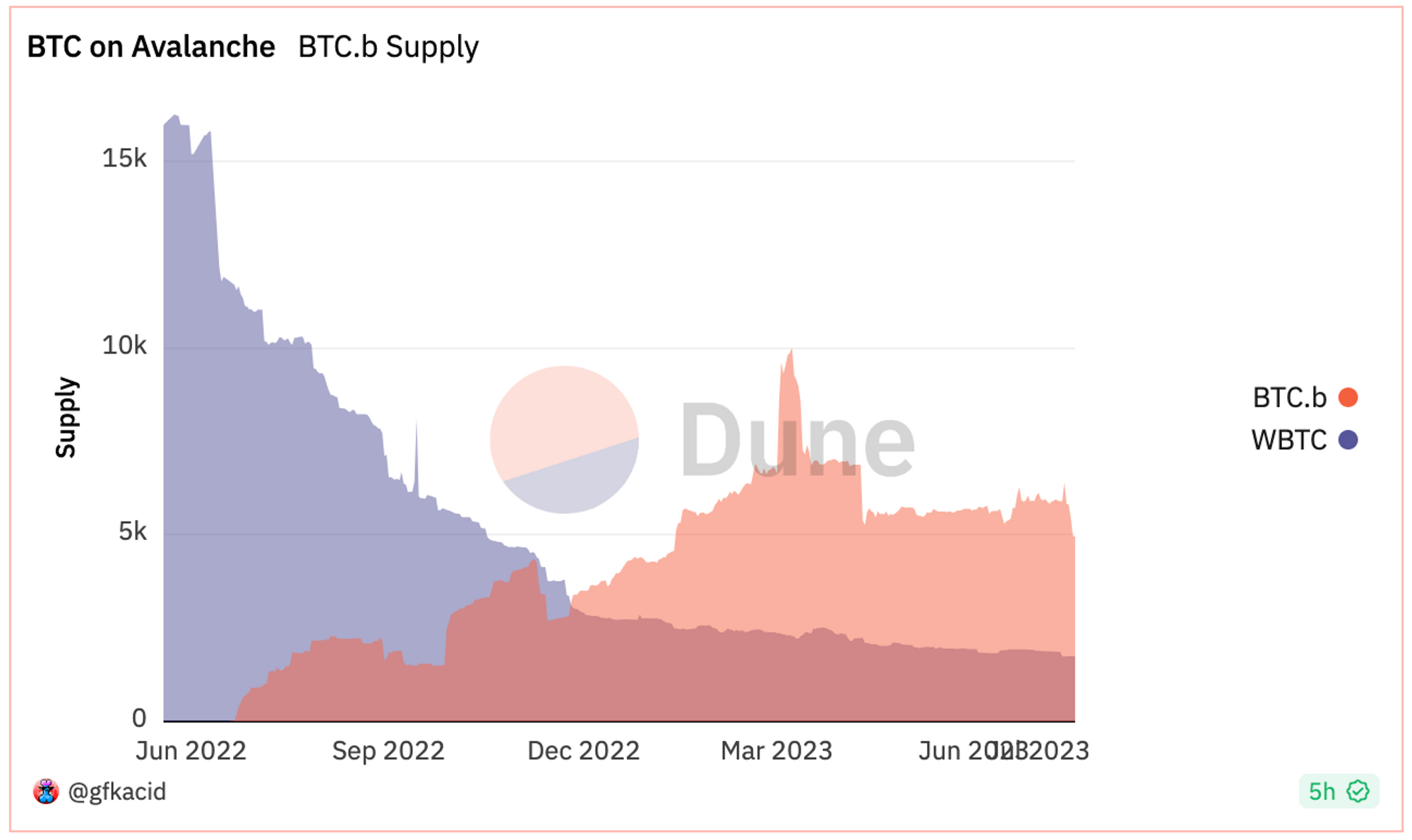
BTC.b vs WBTC supply – gfkacid’s Dune Dashboard
In short, BTC.b allows users to:
- Mint and redeem their Bitcoin whenever they like
- Bridge at a low cost
- Be protected from price volatility & risk of depegging
- Participate in DeFi to earn yield on their Bitcoin
The previous risks associated with WBTC have now been replaced with a decentralized, borderless Bitcoin, marking the beginning of a new chapter in Bitcoin’s development.
A Borderless Bitcoin
In its evolution, BTC.b has become an Omnichain Fungible Token (OFT) built on top of the LayerZero protocol. This transforms BTC.b into a composable asset that can be used on Avalanche and all other major networks supported by LayerZero – including Ethereum, Polygon, Arbitrum and Aptos. OFTs function as native assets across all supported networks, which removes the need for reliance on centralized bridges.
The adoption of a universal token standard not only unifies liquidity but also enables seamless integration for protocols, thereby significantly enhancing the scope of yield-generating opportunities across the vast blockchain landscape.
A Look into BTC.b on Avalanche
At the time of writing, there is a current supply of 4955 BTC.b with a market cap of $148M. The majority of BTC.b opportunities are on Avalanche, which holds a significant 98% of the total supply. BTC.b has effortlessly exceeded the capacity of Bitcoin on the Lightning Network, which is Bitcoin’s scaling solution. Earlier this year in March, it reached an all-time high supply of 10,000 BTC.b.
BTC.b’s journey so far not only provides a glimpse into its immense potential but also signals an inevitable growth in demand as more individuals and institutions discover the opportunities it presents.
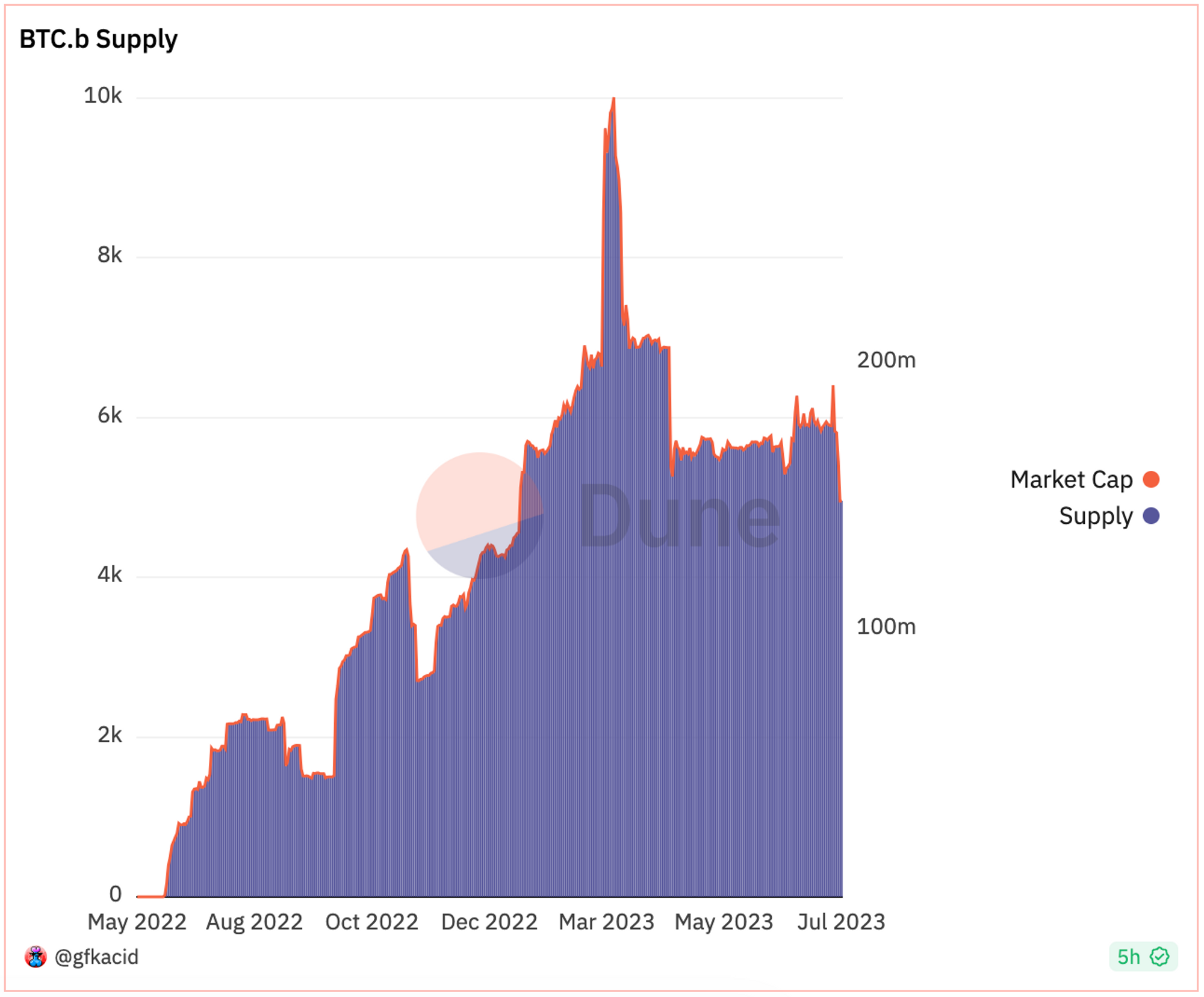
Overview of BTC.b lifetime supply – gfkacid’s Dune Dashboard

Bitcoin capacity on the Lightning Network – txstats
BTC.b Opportunities on Avalanche
The landscape of yield-generating opportunities on Avalanche is diverse, accommodating a wide spectrum of risk tolerance levels. Here are some notable strategies:
- Fixed rate vaults on Struct Finance offering 10% on your BTC.b
- Leveraged borrowing to generate yield across integrated protocols on DeltaPrime
- Supply BTC.b or deposit as collateral and borrow on Benqi or Aave
- Customizable concentrated liquidity strategies using Trader Joe’s Liquidity Book

Where to Bridge BTC.b
To participate in these opportunities, users can bridge their native Bitcoin to Avalanche with the Core browser extension to mint BTC.b, which is facilitated by the Avalanche Bridge.
BTC.b can then be easily redeemed and bridged back to the Bitcoin network using the Core extension.
For those who wish to explore further strategies outside of Avalanche, transfer your BTC.b across multiple networks using Layerzero’s Bitcoin Bridge.
What the Future Holds for BTC.b
As we look to the future of BTC.b, it’s clear that we’re only at the beginning of exploring its tremendous potential. As the number of institutions adopting Bitcoin as a reserve asset continues to grow, it’s likely that we will see the development of on-chain financial products specifically tailored for institutional investors, with a strong focus on BTC.b-centered offerings. This would be enhanced by an expansion of opportunities across multiple networks – leveraging LayerZero’s OFT standard, which enables more complex and robust strategies across various chains without the need for intermediaries. This in turn will inevitably lead to a broader range of automated vaults, further diversifying opportunities for users to participate in, so they can benefit from the evolving DeFi ecosystem in Avalanche and beyond.
Conclusion
BTC.b represents a significant step forward in the evolution of Bitcoin and blockchain technology as a whole. By merging Bitcoin’s transformative vision with the rich DeFi ecosystem on Avalanche, BTC.b is already paving the way for a broader and more sophisticated range of financial products, thereby redefining Bitcoin’s versatility as an asset class. Given that the emergence of DeFi was enabled by Bitcoin’s original concept, it is therefore fitting that BTC.b will play a key role in driving forward a more accessible and inclusive financial system – as this deeply embodies and upholds the core principles Bitcoin was first built upon.

-
Announcing Avalaunch’s Licensed Fork Program


Avalaunch: Steering Growth & Innovation on Avalanche
Avalanche is rapidly emerging as a truly global platform, drawing the interest of financial institutions, native DeFi protocols and established gaming studios, all of whom recognize its potential to transform industries.
Avalaunch has been lucky enough to play a part in the growth of the Avalanche ecosystem since its inception in May 2021. At its core, Avalaunch was built as a people-first platform that served to democratize the fundraising landscape; having served nearly 400,000 participants to date.
What sets Avalaunch apart is that it goes far beyond the perfunctory duties of a launchpad. Over time, the platform’s features, branding and user experience have become an industry standard, effectively raising the bar although; this is but a glimpse into the complete picture. What separates Avalaunch from other launchpads is a commitment to drive the industry forward that requires intimate knowledge of an ecosystem as well as meaningful pre and post “sales service.” Enabling even the most promising teams to turn innovative ideas into sustainable products is ongoing and far more than merely conducting a public sale.
As a protocol, the philosophy is simple – to cultivate genuine relationships with teams by working together and providing hands-on support wherever needed. Even the most seasoned of teams are beginners when it comes to their launch. A collaborative journey is a must, in order to build strong momentum in the earlier stages of a journey and to kickstart community—a key aspect of any Web3 project.
Expanding Impact: Avalaunch’s Licensed Fork Program
Avalaunch has been approached on innumerable occasions to expand their offerings to include other ecosystems. In keeping with the core philosophy, the company has respectfully declined as diluting effort across ecosystems would be a disservice. It is mission critical that the passionately-built knowledge and brand serve to advance the blockchain as a whole. In line with this, Avalaunch is excited to announce an official program which grants licensed forks to teams that meet the requirements and share a collective value set.
Who Will Be Granted a License?
Avalaunch’s brand represents a commitment to nurturing innovation and empowering teams as well as communities to directly contribute to the growth of the industry.
Teams who are granted a license will be expected to:
- Understand and commit to Avalaunch’s principles.
- Recognize that in addition to forking any technological solutions, they will also be adopting Avalaunch’s philosophical and cultural ethos.
It is essential to ensure that the integrity of this vision is preserved. Therefore, licenses will only be granted to teams demonstrating deep alignment with Avalaunch’s values.
What Does It Mean for XAVA Holders?
Generally speaking and with specific details yet to be released, XAVA holders will have exposure to any project seeking to build upon the project’s history and brand. After all, Avalaunch’s accomplishments thus far have only been possible thanks to an exceptional community.
With the launch of the new program, XAVA holders will become eligible for airdrops when new licenses are granted. XAVA holders will also have the opportunity to participate in sales on Avalaunch for the tokens of these newly licensed protocols.
Is There a Fork Planned?
The short answer is: yes.
The new licensing program signals the next chapter in extending Avalaunch’s mission to democratize blockchain innovation and looks forward to announcing more about the exciting journey that lies ahead.

-
The Evolution of Avalanche Subnets
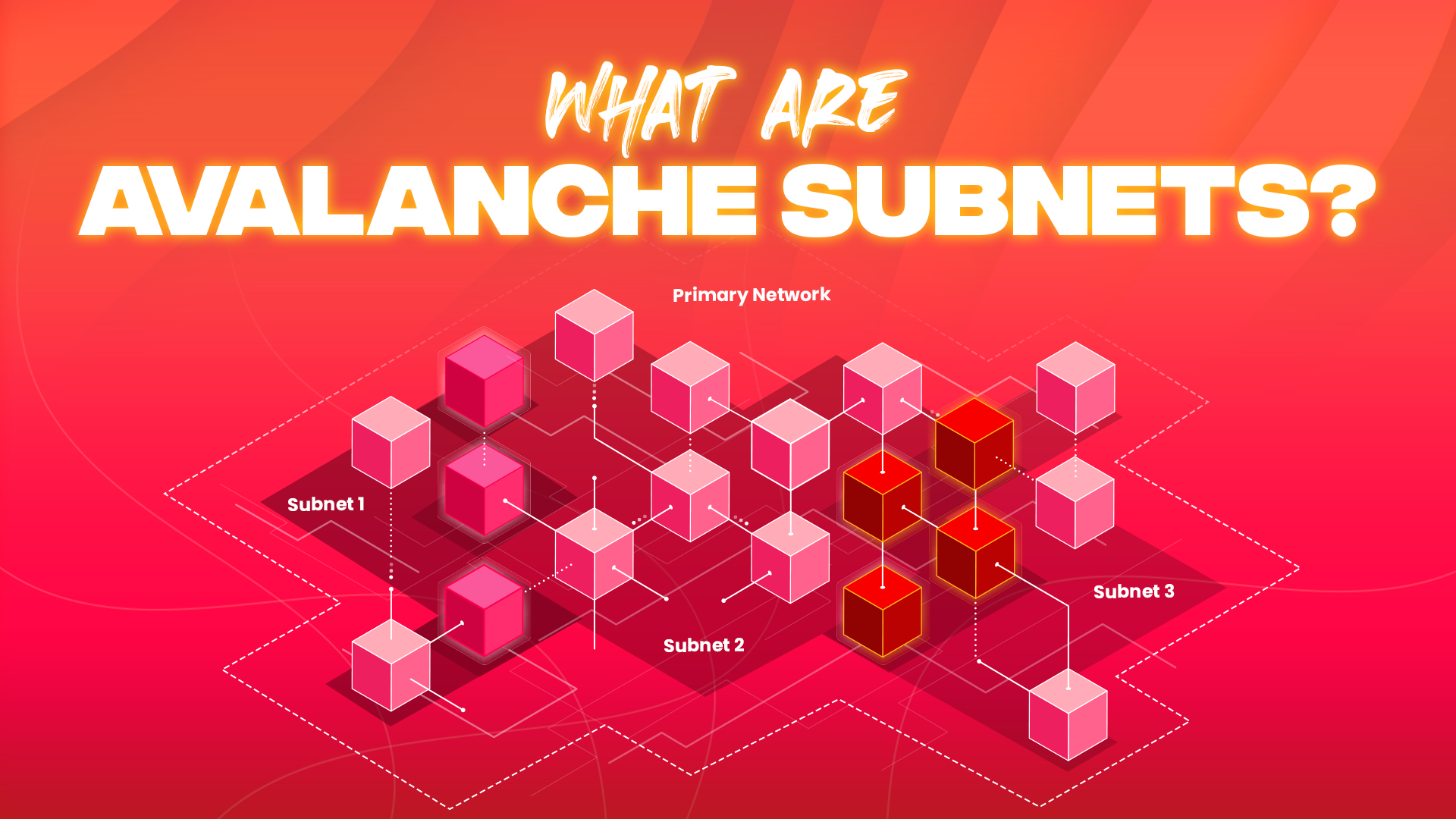

In this article, we delve deep into the world of Avalanche Subnets, breaking down the features that make them such game changers in the blockchain industry. We will unravel the Subnet evolution to date, by looking into the key technical updates that have shaped them into such effective global frameworks. This overview aims to shed light on their impressive transformation in just over a year, showcasing the major developments being made in this rapidly-evolving industry.
What are Subnets?
Subnets are powering the explosive growth of Avalanche by allowing infinite horizontal scaling and rapid experimentation with new models and ideas.
On the foundational layer, Subnets are sovereign blockchains powered by Avalanche’s revolutionary consensus mechanism which enables them to have the fastest time-to-finality – a key consideration for any product utilizing blockchain technology. Simply put – Avalanche is a lightning-fast platform that provides users with a seamless experience.
Architecturally, Subnets consist of a dynamic set of validators who must also validate Avalanche’s Primary network. This design not only maintains a strong security layer but also encourages decentralization. Their most distinctive feature is the high level of customizability they offer, which gives developers the freedom for innovation.

What can be customized?
- Validator Set: Subnet creators can choose who validates their Subnet by specifying requirements. By setting certain parameters, this can ensure that Subnets have the flexibility to meet regulatory compliance – a crucial factor for any platform trying to make a global impact. This could include:
- Geographical location
- Hardware specifications
- KYC
- Permissioned vs Permissionless: The ability to adjust the privacy settings of a Subnet makes it much easier for organizations such as financial institutions to comply with regulations, yet still have a gateway into the permissionless world.
- Virtual Machine: Although the EVM has long been the dominant VM for Web3 builders, it isn’t the ultimate solution for mass adoption. Subnets give developers the freedom to build their own custom VM or leverage HyperSDK, an out-of-the-box solution to build super-fast blockchains. This flexibility empowers teams to tweak their VM behavior precisely to cater to their application needs. Whether it’s prioritizing speed for games or optimizing transaction ordering for DeFi, the possibilities are endless.
- Subnet Gas Token: By allowing Subnet creators to choose their native Subnet token, teams can have a more effective control on their product’s economy. It also unlocks the ability to tweak gas parameters, thereby enabling gasless interactions for a smoother user experience.
The combination of these features positions Subnets as one of the most powerful scaling solutions, that doesn’t compromise on security or decentralization. It’s easy to see why they have attracted so many businesses to build on Avalanche.
A Timeline of Technical Updates
Subnets have only been live for just over a year, but in an industry where the underlying technology is constantly evolving, it can be easy to forget how far we have come.
Let’s put it into perspective by looking at the significant technical updates Subnets have undergone so far:
Banff: Elastic Subnets (October 2022)
The Banff AvalancheGo v.1.9 update introduced ‘Elastic Subnets’, a feature that allows anyone staking on P-Chain to also validate Subnets. Subnet creators now have the option to transform their Subnet into an Elastic Subnet if they wish to open up their validator set. This innovative feature allows nodes to stake custom tokens for Subnet validation. As a result, Subnets can tap into the wider validator ecosystem whilst setting up an incentivization structure for rewarding validators.
This was the first step in pushing towards Subnet validator decentralization and also unlocked another layer to the validator economy. It was also a pivotal moment where Subnet creators and validators could work together to grow the entire Avalanche ecosystem.
Avalanche Warp Messaging (December 2022)
While Subnets enable scalability, the establishment of a global network capable of handling the world’s assets requires seamless interoperability to unleash its true potential. Avalanche Warp Messaging (AWM) brings fast, native communication to all Avalanche Subnets without the need to rely on third party bridges. This effectively eliminates a central point of vulnerability since bridges hold a high value of assets, making them a lucrative target for malicious actors.
On a technical level, AWM uses a cryptographic technique called BLS-Multi Signatures. This enables Subnet validators to collectively produce one signature that proves the validity of a message, verifiable by any other Subnet. Since Subnet validators also validate the Primary Network, they can access the stake weights and BLS public keys of any other Subnet at any time – removing the need to constantly send updates. As BLS-Multi Signatures are always aggregated into a single signature, AWM can achieve high efficiency within a lightweight framework.
AWM also gives developers a high degree of customization. Subnets have the power to determine their own rulesets for how AWM is used, such as choosing which other Subnets they want to interact with and specifying the weight a BLS-Multi-Signature must have to be valid. By having a low level of specifications, AWM gives developers the freedom to not only build more sophisticated communication structures but also refine the UX to create the ultimate interoperability solution.
Avalanche has the quickest time-to-finality, which is what makes AWM so powerful. This is an important parameter for AWM since the source Subnet transaction must be finalised before calling another Subnet. The combination of a lightweight messaging primitive together with Avalanche’s sub-second time-to-finality truly unlocks the composability between Subnets in the most seamless way for users.
HyperSDK (February 2023)
The capability to build custom Virtual Machines on a Subnet was already a powerful feature in itself. However, the introduction of HyperSDK has taken this concept to a whole new level by enabling developers to construct next-generation blockchains out-of-the-box. The HyperSDK framework accelerates the custom VM process from months to just a few days – empowering builders to focus on the customizations they need to create a superior execution environment for their application.
Although still in its early stages of development, HyperSDK is already able to achieve an impressive 50K+ TPS with sub-second finality, giving us a glimpse into the future of blockchains. As an open-source framework, developers are invited to collectively participate in developing this powerful tool alongside the Ava Labs engineering team.
Never has it been easier for developers to leverage Avalanche’s speed to build powerful blockchains, perfectly optimized for their applications. HyperSDK is a major milestone in Avalanche’s vision of creating a unified network of highly-optimized blockchains.
Glacier API beta (March 2023)
The beta launch of Glacier API is the comprehensive solution for all blockchain data needs, and is the official API service indexing Avalanche Subnets. Using all the data for native assets, ERC-20s and NFTs on Avalanche, Glacier API powers the Avalanche Block Explorer and Core Wallet. By granting developers access to a comprehensive data toolkit, Glacier API enables them to easily build products that leverage real-time and historical transaction data.
It will be exciting to see the new products that are built using Glacier API to further enhance the Avalanche ecosystem.
Join the Subnet Revolution
Each technical update signifies a crucial step forward in building a Subnet-powered future; a future that will revolutionize the world as we know it. Even though Subnets already offer a powerful framework for innovation, we have yet to see their full potential. With Ava Labs, along with Avalanche’s vibrant developer community continuously refining these features and rolling out updates, we’re laying the groundwork in real-time for a future of untapped possibilities.
If you are interested in directly shaping Avalanche’s future, you can:
- Join the Glacier Beta discussion on the Avalanche Forum
- Demo Glacier and submit UX feedback or report bugs
- Participate in the HyperSDK public devnet – find out more by joining the HyperSDK Discord, Builders Discussion and GitHub Repo
For those who would like to experiment with the powerful features of Subnets, start by checking out the Avalanche Developer Docs.

- Validator Set: Subnet creators can choose who validates their Subnet by specifying requirements. By setting certain parameters, this can ensure that Subnets have the flexibility to meet regulatory compliance – a crucial factor for any platform trying to make a global impact. This could include:
-
Avalanche Subnets: The Journey So Far
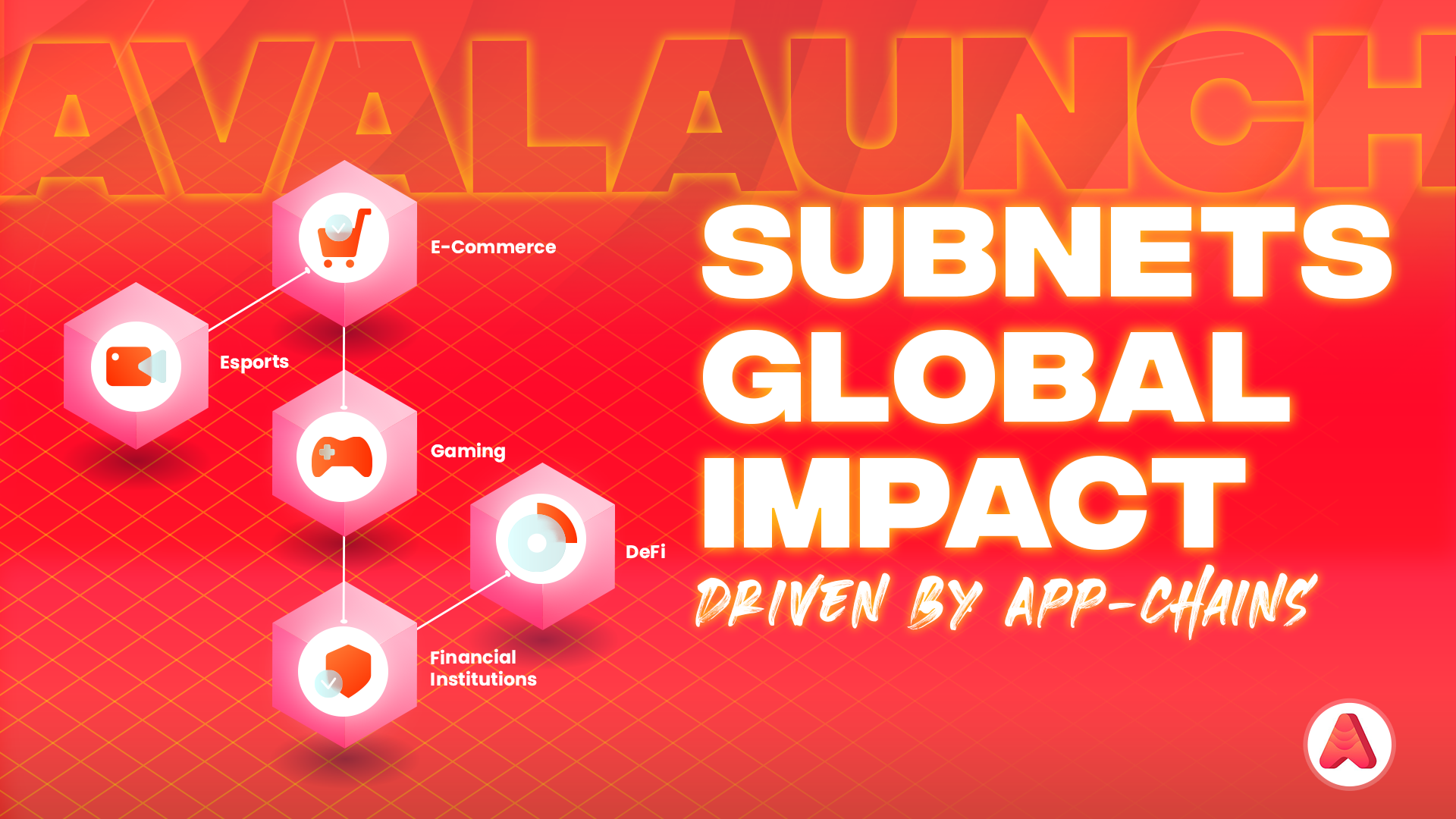

Since the launch of the first Subnet 15 months ago, Avalanche Subnets have seen an extraordinary surge in growth. In this piece, we will be exploring the significance of AppChains and the impact they will have on a global scale, and also map out the development of the Subnet landscape. As we celebrate the remarkable journey so far, we’ll also look at how Subnets will supercharge blockchain adoption in the exciting future that lies ahead.
The Rise of AppChains
Blockchain technology has always been about creating a more open infrastructure to empower industries and individuals in a world where transparency is urgently needed. But in order to have a global impact, we need networks that can scale, to absorb the world’s assets and bring them on-chain. When we look back at the internet boom of the late 1990s and early 2000s, it’s clear that the biggest value accrual was found in the application layer, with the likes of Google, Amazon and Facebook. These applications have shaped the world we live in today and have vastly improved the quality of our lives and are things we largely can’t live without. But as the need for decentralized infrastructure becomes more crucial, people are turning to the benefits of Web3 and we are seeing same scenario play out – it is the *applications* that will onboard the next billion users. With a shift in focus to giving users the most seamless experience, developers have realised that they need more freedom in order to achieve this and as a result, we have witnessed a rapid growth in the AppChain landscape – with Avalanche Subnets leading the way.
Avalanche’s Subnet Landscape – July 2023
Avalanche has always had one mission – to digitize the world’s assets. By bringing these products on-chain, we are not only increasing transparency and improving operational efficiency, we are also seeing the beginnings of consumers gaining access to products and services that up until now, have been out of reach. In the past 15+ months that Subnets have been live, we have seen a gradual acceleration in businesses who are choosing to leverage the power of Avalanche Subnets. With the speed and customizability Subnets offer, gaming studios and financial institutions have so far emerged as the leading adopters. Avalanche is staying true to its mission and leading the way for Web2 companies to embrace the transformative potential of blockchain technology. To truly appreciate the rate of Subnet adoption, let’s look at everyone who has chosen to build on Avalanche:
First Movers
DeFi Kingdoms
In March 2022, DeFi Kingdoms was the first project to launch on an Avalanche Subnet, with its Crystalvale expansion. The cross-chain RPG fantasy game also packages gamified DeFi elements, such as staking and liquidity providing, and is powered by its native token – JEWEL. DFK has completed over 500M transactions and currently accounts for around 75% of all Subnet daily transactions.
Crabada
Crabada’s NFT crabs took Avalanche gaming by storm and at multiple points, was responsible for over 30% of activity on the C-Chain. Crabada’s popularity was a prime example of why games needed their own dedicated environments to give the best experience to players. With the launch of Swimmer Subnet, Crabada was able to provide players with low transaction costs and alleviate congestion on the C-Chain. Although Crabada and Swimmer Network have both since wound down, they served as important lessons in Subnet development. The Crabada NFTs have become open-source for anyone to build upon and explore the possibilities of a decentralized game IP.
Esports
Loco
Loco, the largest Esports platform in India with 55M+ users, is revolutionizing fan experiences through its Legends by Loco Subnet. Positioned as an innovative entertainment hub, Loco is building a suite of Web3 apps that creatively use digital collectibles. These apps will provide new ways for fans to engage with their favourite streamers, enabling a deeper sense of community which will help fuel the industry’s evolution. Driven by the exponential growth of online gaming in India, Loco’s Subnet will be customized to provide a low-cost and fast experience for millions of users, whilst Avalanche Warp Messaging will allow Loco users to use their collectibles across the wider Avalanche ecosystem.
TSM
Global Esports giant, TSM, will be onboarding 30M+ players to Web3 with the launch of the Blitz Subnet. Powered by Avalanche’s Core Wallet, Blitz will be a powerful coaching platform providing performance analytics and tools to help gamers improve their skills. A pioneer in the Esports industry, the Blitz Subnet will play host to Avalanche-branded tournaments in this close partnership. TSM plans to utilize the Elastic Subnet feature to empower the community to actively participate in validating Blitz and play a direct role in driving its growth.
Financial Institutions
Evergreen Subnets
Evergreen is an official suite of tools specifically curated for institutional blockchain deployments, to make it easier for institutions to launch permissioned blockchains that are tailored to meet regulatory requirements. Leveraging the customizability of Subnets, Evergreen will enable financial service providers to explore blockchain-powered features. These include tokenization, composability and operational efficiency, all within a private environment.
Avalanche has also launched Spruce Testnet, which gives institutions the ability to experiment with the power of Subnets without having to put any capital at risk. It also allows partnering institutions to provide feedback – a crucial component to the ongoing development of Subnets and its suite of institutional tools. Spruce’s initial cohort of partners includes asset managers – T. Rowe Price, Wisdom Tree and Wellington Management (who cumulatively hold close to $3 Trillion AUM) as well as diversified trading firms – DRW Trading and Cumberland.
With Evergreen and Spruce, Avalanche has the framework to work closely with partners to collectively advance the broader institutional adoption of blockchain technology.
Intain
Intain is the first structured financial service to build an Evergreen Subnet with IntainMARKETS – a marketplace for tokenized asset-backed securities.
IntainMARKETS aggregates all key stakeholders into one platform to streamline digital issuance and investment and thus majorly increasing operational efficiency, which will allow Intain to be more economically sustainable. This enhanced efficiency lowers costs for issuers, unlocking access to a broader investor base with smaller transaction sizes. The blockchain-enabled features offered by Subnets greatly improve the investor experience by providing real-time transparency for every loan backing an investment as well as timely reward collection – two key benefits which were not possible in traditional markets.
It’s important to note that IntainMARKETS has US-hosted infrastructure and uses a permissioned design, requiring its validators to be verified US entities and individuals. This is a perfect example of how easily Subnets can be configured to comply with regulatory requirements.
DeFi
Dexalot
Dexalot’s Subnet takes Avalanche’s speed and ingeniously blends the trading experience of a CEX into a DEX via the use of on-chain central limit order books. Its goal is to provide users with the ability to trade with low fees and ultra-fast time-to-finality, all without compromising on decentralization and transparency. As the first DeFi Subnet, Dexalot brilliantly exemplifies how users can enjoy a superior trading experience whilst maintaining custody of their assets. This represents a significant step in demonstrating the real use cases of DeFi applications.
MELD
The MELD Subnet is revolutionizing the future of finance by combining regulated banking services with the transparency and composability of DeFi. With a vision to create an empowering ecosystem of services, MELD offers users self-custody and access to an array of financial products, including crypto-backed loans and debit cards. By using Avalanche’s Subnet architecture, MELD can customize the platform’s security features while ensuring seamless interoperability with the broader network.
E-Commerce
SK Planet
SK planet, one of South Korea’s leading data management and marketing platforms, has partnered with Avalanche to launch the UPTN Subnet. UPTN will serve as the foundation for South Korea’s shift into Web3 e-commerce, impacting millions of users. By integrating UPTN into SK Planet’s many services, such as OK CASHBAG – the largest loyalty program in the region, South Korea will be strongly positioned to continue pushing the boundaries in e-commerce and Web3.
Gaming
Avalanche is emerging as the go-to-blockchain for games exploring blockchain features, due to its speed and powerful customizability features. Here are the studios that have chosen Subnets as their engine to build the next generation of gaming:
Merit Circle – Beam
With 60+ partner games, Merit Circle is a leading gaming DAO that will be launching Beam – a Subnet built specifically for game developers and gamers. Its development-focused tooling and products will be instrumental in the gaming evolution. Initially, Beam will be home to 3 new games but the vision extends much further. By providing all the tools and support for game teams, Beam will have the power to grow into a thriving ecosystem where developers can focus on crafting immersive experiences for players. With this focus, Beam is set to be a driving force in the Web3 gaming space by creating a home for anyone who is passionate about gaming.
GREE
Japanese gaming powerhouse, GREE, has chosen to work closely with Avalanche to accelerate blockchain gaming in Japan. Already a pioneer in the traditional gaming industry, GREE has played a significant role in launching mobile games for renowned titles including Naruto and Final Fantasy. With plans to onboard its 30M+ users, GREE will create a vibrant ecosystem of new games through its subsidiary company, BLRD.
Shrapnel
Shrapnel is a highly-anticipated dystopian AAA first-person shooter (FPS) built by an elite team with a wealth of experience in the gaming industry.
Gunzilla
Gunzilla, an independent AAA game studio is launching their GUNZ Subnet, which will be home to their upcoming title: ‘Off the Grid’ – a Battle Royale 2.0 game. Gunzilla is building gaming-specific tooling to help developers launch in the Web3 space. These services include a marketplace, an NFT minting engine and the GUNZ SDK, all aimed at accelerating the deployment process.
DOS
DOS Labs, a gaming studio with 400K+ daily active players, has launched DOS Chain – a gaming Subnet focused on providing game developers with powerful tooling to make it easier to create Web3-enabled games. DOS Labs has formed an alliance of 11 gaming studios, to advance the widespread incorporation of blockchain technology within the gaming industry.
The first game on DOS Chain will be MetaDOS, a Battle Royale game with a ‘time-as-currency’ concept.
To cement their position as the leading gaming platform. Avalanche has launched the Arcad3 initiative, of which Avalaunch is a proud partner. Arcad3 is a pioneering program that is focused on accelerating Web3 adoption in the traditional gaming space. By drawing on the expertise of the ecosystem’s key players, Arcad3 will play a crucial role in shaping the future of gaming.
AvaCloud – the Future of Subnets
In May 2023, Avalanche announced the launch of AvaCloud, which enables businesses to deploy fully-supported blockchains that easily adheres to regulations and is tailored specifically to their product – all in a matter of minutes. AvaCloud’s goal is to empower businesses to embrace blockchain technology by eliminating the need for heavy resources and blockchain expertise.
AvaCloud’s product suite has 4 key components:
- Automated Blockchain Builder: a no-code portal that allows businesses to launch customized blockchains in minutes, with the support of a dedicated team of experts.
- Managed Validators: automated updates and scaling of validators to ensure maximum security and optimal performance.
- Comprehensive Data Tools: allows access to a rich data source from across the Avalanche and Ethereum networks to effortlessly power products requiring all types of data.
- Chain Interoperability: Avalanche Warp Messaging will allow seamless communication between all Subnets and unlock new possibilities between chains.
AvaCloud is a major milestone in Avalanche’s mission to digitize the world’s assets. It is set to revolutionize the ways businesses approach blockchain, allowing them to explore new ideas that simply weren’t possible before. By leveraging blockchain infrastructure, businesses are democratizing access to their products and building towards a more transparent world.
The Subnet activity from the past year is just a glimpse into what the world looks like on-chain and AvaCloud’s arrival signals an imminent gear-shift in Subnet adoption. This is a pivotal moment where entire industries are being reimagined and Avalanche Subnets are central to this transformation. Soon, embracing blockchain infrastructure will no longer be a choice, but a necessity. And with the launch of powerful products such as AvaCloud, the emergence of that future is in sight.

-
Heroes Chained AMA – Game Update & FoV (Recap)
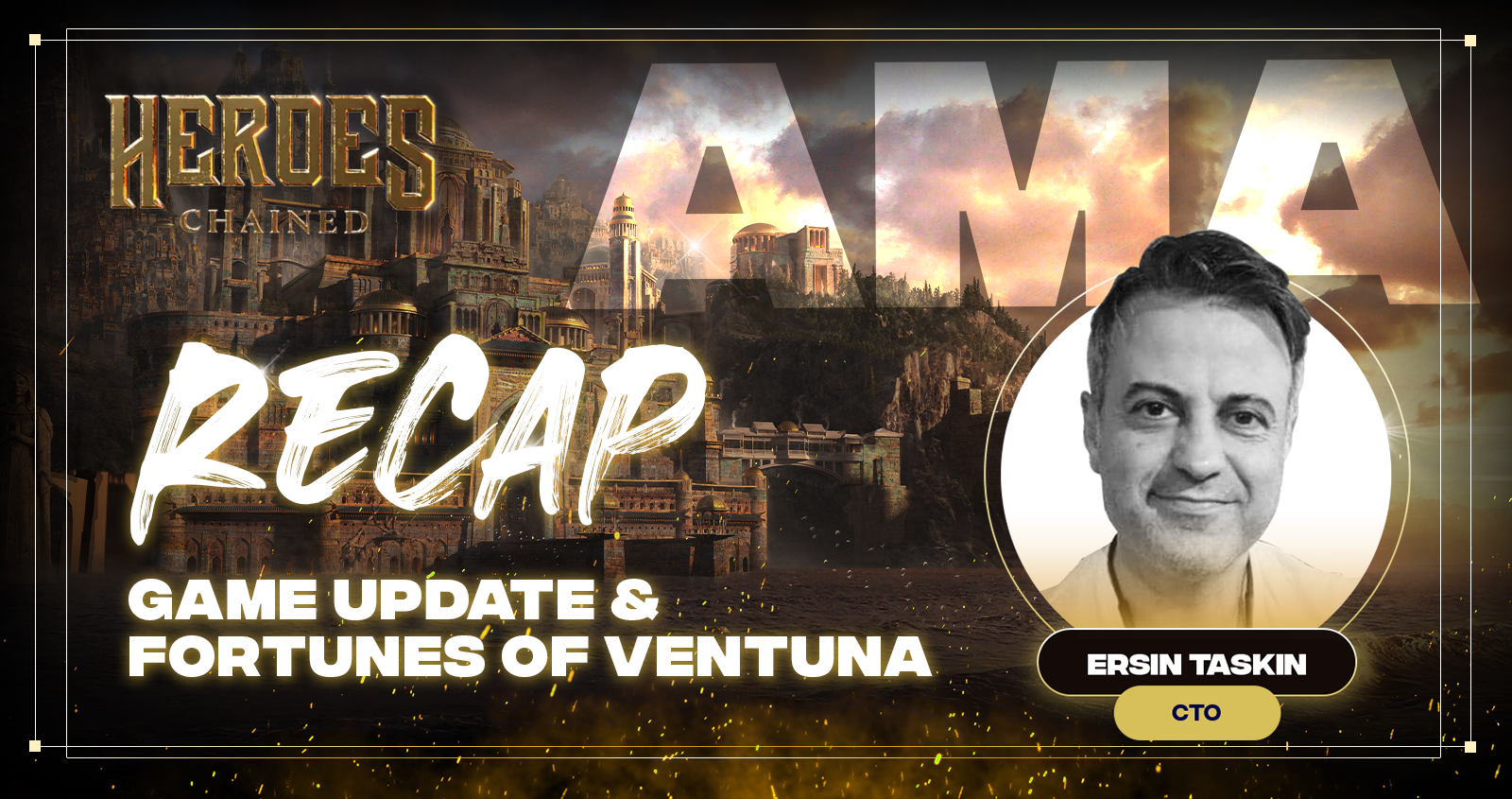

On 6/1/2023 at 6:00 a.m. (UTC), an AMA session was held in the Avalaunch Telegram Group with Heroes Chained co-founder and CTO, Ersin Taskin, to cover the recent Heroes Chained game progress as well as Fortunes of Ventuna (FoV), their idle mini game that shares many of the same NFTs (characters, weapons, etc.) with Heroes Chained.
Below we present to you an excerpt from AMA with questions and answers.
Dave | Avalaunch
Welcome all to another AMA brought to you by Avalaunch. It is indeed a special occasion because we have a follow up with a previously launched project in Heroes Chained. Heroes, for those of us still in the game, assembled an all-star cast and launched their IDO about 17 months ago and have done their very best to build and deliver. It is the first time we’ve had a follow on with a team and today I am happy to be joined by @ersintaskin , their CTO and one of the people bringing cutting edge gaming to Web3. Welcome. How are you today?
Ersin Taskin | Heroes Chained
Thanks bro, feeling great as things get released 🙂
Dave | Avalaunch
Well it’s good to have you. Let’s get right into for those familiar and those just getting acquainted with Heroes Chained.
A lot has happened since you were last a guest and it’s encouraging to see you all still building. How is the team and for those not familiar, maybe you can give us a high level overview about this star studded cast?
Ersin Taskin | Heroes Chained
Thank you for your kind words. We advocate game-first and hence team-first. We have doxed our core team members on our website, extensively. I suggest people check the team section of our website to see that it is the best doxed team, with links to evidence.
The founders are also the founders of the two top software companies of the country, namely KodA and CBKSoft, with exceptional track record. KodA is a top-ten software company in Turkey and market leader in its domain. CBKSoft develops the highly reputable enVision BPM. It is the market leader in 20 countries. It was acquired by Infofort and then Iron Mountain eventually.
Mev Dinc, co-founder has developed award winning games for his studio, and giants like Activision, Ubisoft, Nintendo, etc.
Onur Cayli has taken part in the creation of the White Walkers race for Game Of Thrones, and did the same for The Amazing Spider Man, Terminator Genisys, Avengers: Age of Ultron, Antman, Man in Black 3, Marvel vs Capcom, Sonic, etc. He has created our Mayinhara race and our world concept.
An finally, we worked with a great blockchain team and won the first ever Avalanche Hackathon together. So, we are equally strong there.
Dave | Avalaunch
Yes Sir. The team needs no introduction in gaming circles that is for sure and for the true fans, Mev’s autobiography is a good read.
How are things going with Heroes Chained? At last turn, it looks like you’ve doubled down on development but before we get to the newest, “idle” iteration, how are things going with Heroes Chained?
Ersin Taskin | Heroes Chained
HC is both PC & mobile. As you know, we released our PC version open beta in 22Q3. We received a great deal of feedback and compliments, then. We have been working on the mobile version in parallel. We decided to release both versions at the same time. Last week we had our mobile version battle mode closed beta test. That was very successful as well.
Dave | Avalaunch
Well done. That of course will bring us to something I’m sure you’re excited to talk about.
Ersin Taskin | Heroes Chained
I personally found it difficult to get through the dungeons. Then our CEO Erhan, who is an avid gamer, taught me some tactics. Wow, you really need to do some reading and learning about the classes, races, and skill/spell cards. The gameplay is easy to learn but deep to master. Can’t wait for the PvP mode. It will most probably evolve to tournaments and e-sports. I imagine a cult like Magic the Gathering evolving here.
Dave | Avalaunch
The depth that top tier games go to and you poring over this stuff is impressive.
In that vein, please tell us about Fortunes of Ventuna.
Ersin Taskin | Heroes Chained
Thank you 🙂
The idle game was not on the roadmap, and technically it is a challenge. However, we have decided that the Mayinhara NFT holders would benefit of their NFTS before the main game release and we added FoV, the idle game, on the roadmap. We now have FoV 2.0, and added the Defiance release. FoV is very active and we got very positive feedback so far from our community.
We, also were able to test our non-custodial/off-chain technology on FoV before HC. We always listen to our community and take their suggestions into account. So, we can say that the community gets involved with the game development with their NFT Mayinharas. FoV became one of the highest traffic games on Avalanche, and an organic use case where Web3 is the better option for game development.
Dave | Avalaunch
I didn’t know it wasn’t on the roadmap. That’s a lot of work for an additional project that made it on to the main stage.
which brings me to my next question — How challenging is it to make what is essentially a separate game while incorporating the storylines, characters, weapons i.e. it seems like all the NFTs into this?
Ersin Taskin | Heroes Chained
The lore, races, classes, NFT items are the same in both games. And you know HC has a great lore. FoV is a totally different game i.e. different genre, gameplay etc. It is for prolonged game-play by the early adopters and investors and its time scale is very large. One battle can take days in FoV and minutes in HC. FoV is a web game while HC is native PC and mobile. So FoV is basically a distinct game from a development perspective.
However, the core of creativity is the same. The lore, classes, races, items are the same. Therefore, we can use the same NFT ownership 1–1. All you need to do is an extra representation of the same item. You use the 3d model of your hero in HC and 2D model in FoV for example. It is an extra cost and challenge, but it is worth the effort. We have two independent teams for both games and we will continue to improve both.
Dave | Avalaunch
That is a lot. Kudos to you all and for listening to the community. It’s a lot to manage and balance.
That said, how do you strike the balance between dealing with speculators vs. gamers? It’s been an ongoing discussion for the metaverse as valuable assets, like great games, accrue their value from players while having to essentially *answer* to an investing audience.
Ersin Taskin | Heroes Chained
That is the holly question. Remember that Heroes Chained has introduced the “Play-and-Earn”, challenging “Play-to-Earn”. It has started the “Game-First for GameFi” meme in 2021 when the p2e hype was rising. So, HC is designed and developed to be a fun game. That is why it took us a great deal of time and effort.
In free market economy or capitalism you have investors, speculators and users. It is natural. You have the same in web3 gaming. You have gamers as users and the ratio of individual investors and or speculators is higher, which we may call democratization of investment or speculation if you will. The best way to cope with both investors and users is easy to know and yet hard to implement. Develop the best product for the users and do the marketing well. So, web3 is no different in that sense. Some investors will get the earnings they deserve. Investment involves speculation, which is OK as long as you develop well.
Dave | Avalaunch
Well said and there is often something of an adversarial relationship between parties. Gamers are slowly starting to warm to web3 but it’s still ongoing.
Ersin Taskin | Heroes Chained
Indeed.
Dave | Avalaunch
It’s always worth visiting what brought us here. How are you feeling about the technological advances on Avalanche and how does that bode for the Heroes Chained/FOV architecture?
Ersin Taskin | Heroes Chained
Avalanche is a top tier blockchain with its speed and cost-effectiveness. The flexibility of subnet approach also makes it long term friendly. Now that we have AWM for seamless and secure communication among subnets we the technical people are more relaxed. WE also added off-chain option for those who dont want self custody. And ecosystem, ecosystem, ecosystem.
Dave | Avalaunch
Agreed. The horizontal scaling/subnet architecture is going to gather critical mass and come into its own. Or so I believe.
Let’s wrap up this part of the AMA with a final question before we move on to the community questions.
I recall from our early conversations that you were among the first to recognize that an NFT should be more than a profile picture. Following the launch of our NFT Marketplace “Peek,” we are always interested in hearing about the application of NFTs with utility. Can you remind us about how some of your NFTs truly go to work in the game?
Ersin Taskin | Heroes Chained
We have a very special race called Mayinhara created by Onur Can Çaylı, uniquely, just like the White Walkers race he created for Game of Thrones. Mayinhara has passive income capabilities and in game advantages. Their holders have supported us at early phases of development. There will ever be 10.000 Mayinhara heroes ever. We sold more than 3.000 heroes until now. You cannot buy or earn Mayinhara when the game starts. Only available in NFT sales before the game release or you may buy secondary market. And we had a very high demand. We thank our community for their support and faith in the project. Mayinhara heroes can be traded on third party marketplaces. We will have all the five classes for Mayinhara Warrior, Tank, Mage, Archer, Healer. Mayinhara has many advantages both in and out of game such as being immortal, they don’t need breeding to reach next generation, getting extra income and bringing some stat boosts, early access rights etc.
We have two types of NFT’s 1. Utility 2. Artworks and collectibles. 1. Utility NFT’s are heroes, items like sword, spell cards, guilds, land etc. They all have utility in the game.
You craft gear, and materials from lower tier resources which you can sell as NFT. This helps buyers save time and effort. You can use your gear and resources yourself as well. For passive and semi-passive income, you explore outside the city walls and find chests, rare NFT items, and resources. You do dungeons for looting items, runes or resources. Battles against NPC enemies. We are working closely with Dexes for integrations. Compounding and yield farming. You can own land outside the city where you can get many benefit of it such as crafting, collecting resources and even getting fees from some activities on your land. In brief it is a metaverse mimicking the real economy. But since it is fun the economy is sustainable.
Dave | Avalaunch
Thank you for the comprehensive answer.
Ersin Taskin | Heroes Chained
Thank you for the opportunity.
Community Questions
Dave | Avalaunch
The game sounds like it’s becoming a robust experience and congratulations on Fortunes. Sounds very promising. Now, moving on, our inquisitive community has a few questions.
First up is @verniadollar who asks an easy question — “are any of the fees generated by the game distributed back to holders/staker?”
Ersin Taskin | Heroes Chained
Yes 🙂 you may do further reading in our Medium channel and follow us on Twitter, Telegram, Discord.
Dave | Avalaunch
Fair enough. 😁 Our sophmore effort is none than @BuckStern who wants to know- “Often — we see multiple tokens in games, why does Heroes Chained only use one?”
Ersin Taskin | Heroes Chained
Simple is the best. You can get tokenomics wrong the more sophisticated it becomes. Remember we are a game and not DeFi. We achieve price stability via FIAT and volatile value via HeC. So HeC represents the censorship resistant, self custody option whose value is in correlation to the size of the game economy. HeC can be staked for governance as well. So we didnot need a separate token for stable price tags, they are pegged to USD.
Dave | Avalaunch
That makes sense. I’ve often wondered why so many games have two token economies where some of the chief utility seems lost in the uncapped “currency” token. Good for you all.
Ersin Taskin | Heroes Chained
Indeed.
Dave | Avalaunch
None other than @Arleenclements inquires — Does Heroes Chained have a free to play version? How do you find a balance between attractive casual/free players while making it exciting for those who hope to earn?
Ersin Taskin | Heroes Chained
Yes we have f2p option. Like all high quality mid-core games which are f2p and include high in app purchase market. We use their best practice. First we need to develop a fun to play game with rich content and gameplay experience involving high variety of experience and gamers. Then we must have a high enough in-app purchase market, which has been achieved many times in the sector.
HC is a normal game using the best practices of the real gaming industry.
Dave | Avalaunch
Right. Good reminder. And next up is our very own @charan_0318n who took a real interest in the project — What are the new features added to FOV 2.0? What are the main differences between using silver and gold bars for crafting weapons in FOV 2.0?
Ersin Taskin | Heroes Chained
New features have arrived with FoV 2.0. Limited gas fee, new tier levels (6/7), sending and claiming heroes collectively, revamped new user interface are just some of these new features. We released FoV Defiance recently and World Boss Event which is a new game mode, crafting weapon, marketplace, inventory came as new features. Please follow us on our social media and especially read our medium articles on FoV 2.0.
Dave | Avalaunch
And our final question comes from @PatrickChan111 — There is a negative prejudice against local projects in our country. What are your plans to break these prejudices? Heroes Chained introduces the concept of “Play and Earn” vs. “Play To Earn” Can you tell us the real difference between the two?
Ersin Taskin | Heroes Chained
HC is not the right project for quick buckers. It is a first class game project. Developing a good game is universal and the market is global. HC has an internationally renowned team, Mev Dinc has developed globally award winning games for example. Other founders have internationally respected startup experiences.
So far HC has been welcomed by the national and global community. Take a look at our backers, and community. And remember we have been rated high for a very long time, continuously. We have been able to keep this reputation for so long by building and releasing actual stuff. At the end of the day nobody cares where the good game they play is developed. And our country is a top country in game development. That is play&earn. It is game-first.
Dave | Avalaunch
That’s an appreciated answer and I thank you for being here today.
Good to hear of all this development as we wind our way through these bearish conditions.
Ersin Taskin | Heroes Chained
Remember bear is when you can concentrate easier on building 🙂
Dave | Avalaunch
and a big congratulations on Fortunes. Amazing to see you all pivot and put together something that was not even on the roadmap. Takes a strong and accomplished team who has their ear to the street.
Ersin Taskin | Heroes Chained
Thank you very much. This summer will be fun. Cant wait to see how this game unfolds 🙂
Dave | Avalaunch
Likewise. Looking forward to it and again, nice to have you here today.

-
Peek NFT’s Debut Sale: The Battle for Giostone Genesis Hero Collection
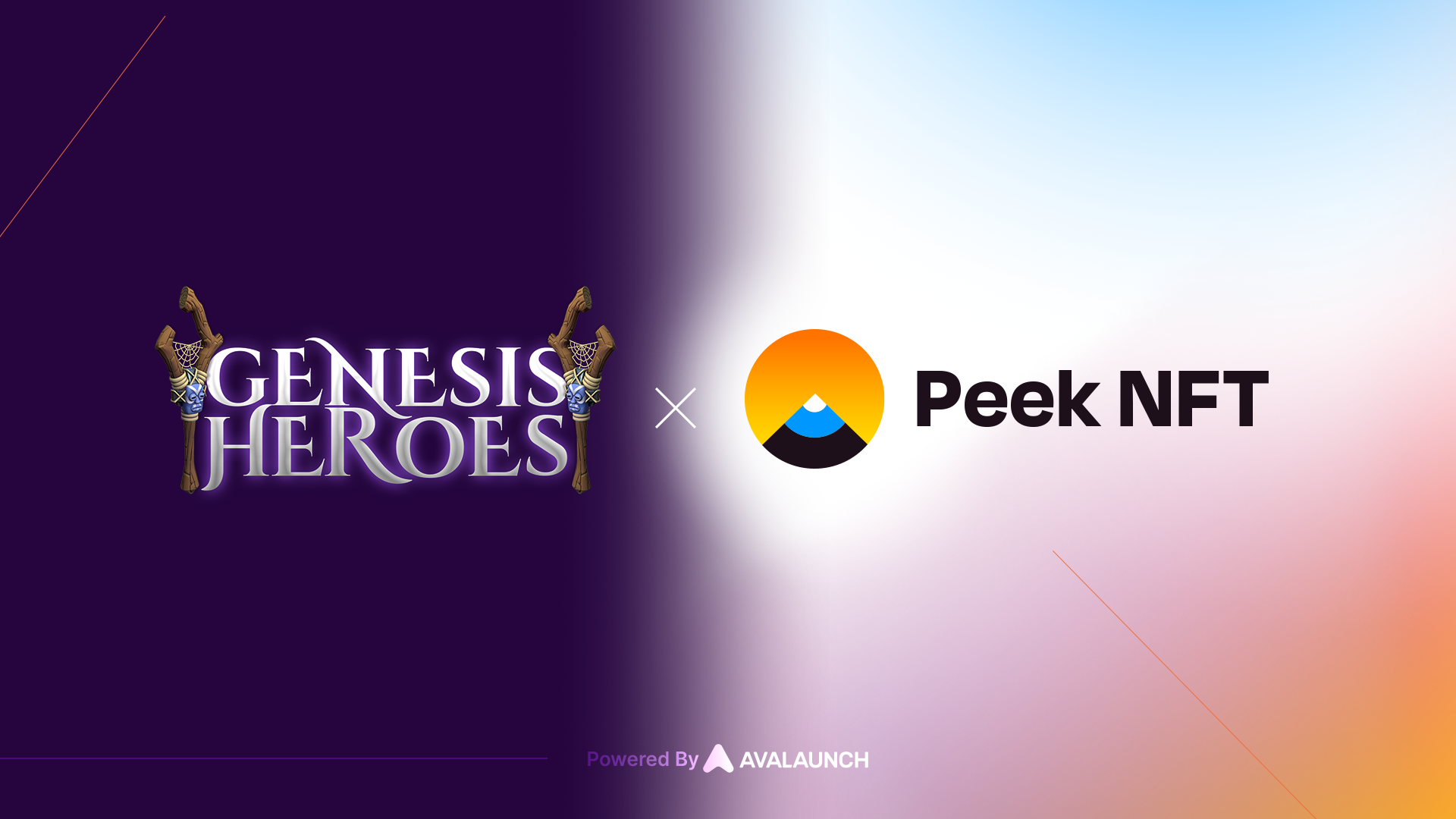

In the ever-expanding universe of Non-Fungible Tokens (NFTs), Avalaunch is excited to present a new marketplace that is crafted with an emphasis on utility NFTs from highly curated collections. Today, we invite you to Peek NFT, a platform devoted to fostering a community of passionate Avalanche NFT explorers and enthusiasts.
The Debut Sale: The Battle for Giostone Genesis Hero Collection
The inaugural Peek NFT sale features Battle for Giostone (BFG), an ever-evolving MOBA game coming off of these recent milestones:
- Transitioned from a closed-alpha version to a community beta.
- Garnered a player base of 5,000.
- Attracted 30,000+ viewers for their esports event, The Primal Giostone League.
- Follow-on investment from Blizzard.
The Plutus NFTs: Enhancing Gameplay and Participation
The sale unveils the Plutus NFTs, a limited collection, where each Genesis Hero provides:
- Unique in-game bonuses
- A share in BFG game revenue
- Two types of Heroes, Forger and Hoarder, offering distinct benefits:
- Forger Heroes reduce your cost for forging new Heroes by 10% initially, with a 1% reduction for each additional Forger Hero, up to a 20% maximum
- Hoarder Heroes boost your earnings within the BFG ecosystem by 10%, with a 1% increase for each additional Hoarder Hero, up to a maximum of 20%
- Unique skin specific to its class, tradable on the secondary marketplace
- Hero backgrounds will represent the in-game skin, with 10 different variations – 4 Common, 3 Rare, 2 Epic, and one Legendary.
- 7,000 total Heroes will be minted.
The Sale Structure and Value of BFG Staking
The sale is structured to prioritize Gold Stakers:
- On May 22nd, 3:00 PM UTC the general sale for the Heroes will begin:
- Period: 4 days
- Mintable Heroes: 500
- Price: 10 AVAX for 50% of the NFTs
- After these are the sold, the final 50% can be purchased for 11 AVAX
- Gold Staker Sale Begins on May 26th, 3:00 PM UTC
- Period: 3 days
- Mintable Heroes: 500
- Gold Stakers can receive a Hero at a price of 9 AVAX
Total Heroes For Sale on Peek NFT: 1000
Powerful Utility
- Genesis Heroes reward stakers with BFG tokens.
- 10,000,000 BFG tokens are allocated for Genesis staking rewards.
- Stakers can enjoy boosted APY during a promotional period following the sale.
- Following the promotional period, BFG’s Genesis Hero NFT stakers will receive a revenue share, distributed quarterly.
Special Modifiers
The Plutus Collection of Genesis Heroes possesses the powers of the Giostone, allowing access to a Special Modifier. Owners gain:
- Access to a Special Modifier for every 10 Genesis Heroes in your account, with a maximum usage limit of three at a time.
- Special Modifiers can include: boosted APY, monthly skin drops, energy refresh (2 uses per week), lower forging times, guaranteed abilities, and increased access to Battle Pass levels.
Conclusion
Avalaunch’s Peek NFT hopes to usher in a new era of utility-focused NFTs, with Battle for Giostone paving the way. The Plutus Collection adds a unique twist to the gaming experience, offering not just in-game advantages but also revenue participation. The innovative structure of the sale and the value of BFG staking with your Hero presents an enticing opportunity for early adopters. The Special Modifiers further enhance the benefits, adding a layer of strategic depth to the game and the NFT ownership experience.
Welcome to Avalaunch. Welcome to the Plutus Collection.

-
Unveiling Peek NFT: Avalaunch’s New Launchpad & Marketplace
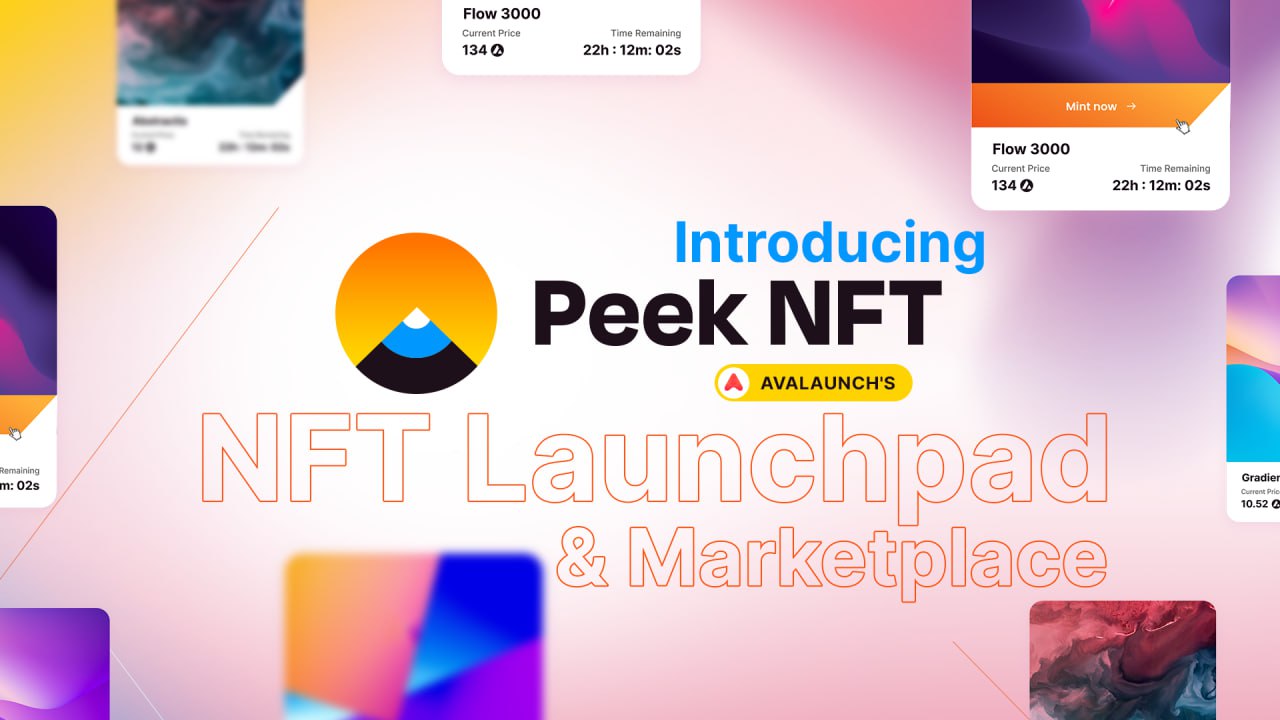

The world of Non-Fungible Tokens (NFTs) exploded in recent years, with new marketplaces and projects popping up every day. However, not all NFTs are created equal, and many lack real utility beyond their speculative value. That’s why Avalaunch is excited to announce the creation of a new NFT marketplace, with a focus on utility NFTs from highly curated collections.
Introducing Peek NFT
Avalaunch’s Peek NFT is designed to be a product that encapsulates a state-of-the-art NFT marketplace with a focus on NFTs that have demonstrable utility. With a clear emphasis on attributes and less on speculation, Peek NFT is poised to redefine the paradigm of NFT trading while offering comprehensive support for initiatives developed on the Avalanche blockchain.
The Peek NFT marketplace will contribute to Avalanche by hosting NFT collections that have a firm place within larger ecosystems. These NFTs are not just collectibles, but specifically designed to add value to both users and the protocol itself. Offering NFTs that can accrue value in lockstep with a protocol’s growth is the aim as non-fungible assets evolve from digital arts to financial instruments and ultimately, RWAs. Let us delve into Peek NFT and how it can emerge as a home for Avalanche-based projects.
Embarking on a Journey with Peek NFT
As Avalaunch persists in its efforts to become more than a launchpad, the team has chosen to foster an environment of collaborative growth within the greater community. Peek NFT does not intend to offer “everything under the sun” but strongly prefers to be notably selective in its offerings.
- Highly curated across verticals with an emphasis on NFTs that offer meaningful utility.
- Avalanche ecosystem based projects.
- Anyone is allowed to participate in our marketplace but:
- Some sales may have rounds that allow access to Gold Stakers participants first.
The goal is to make the marketplace accessible to as many people as possible while also ensuring that the sales are fair and equitable.
- Marketplace Exploration: Delve into the growing selection of Avalanche-based NFTs and uncover hidden gems.
- NFT Trading: Avalanche-based NFTs for sale to diversify and grow collections.
- Community Engagement: Connect with other Avalanche NFT enthusiasts, creators, and collectors to exchange insights, collaborate, and evolve together.
- Participate: Avalaunch will host curated NFT sales where users can gain access to the unique offerings from newly launched and existing projects.
Nurturing Avalanche
Peek NFT transcends the conventional definition of an NFT marketplace. It is envisioned as a robust resource; enabling Avalanche-based projects to launch their sales, expand their audience, and realize their objectives. The team is committed to fostering a community that reciprocates, empowers, and benefits its users as well as creators.
Peek NFT, with its provision of collaborative opportunities is uniquely positioned to catalyze new NFT launches. The Avalaunch platform’s robust community, comprehensive tools, and focus on collaboration can render it an invaluable asset for projects launching or expanding into Avalanche.
Peek NFT is committed to growing a community of passionate Avalanche NFT explorers and enthusiasts alike. By providing a dedicated platform for such participants, it can serve as a rallying point and act as a hub for the community. This new market intends to fuel the genesis of innovative ideas, collaborations, and initiatives that can propel the Avalanche ecosystem forward.
A Sneak Peek
The first sale on Peek NFT will feature a project that had a significant presence at the Avalanche Summit and is receiving a follow-on investment from Blizzard. Given Avalaunch’s history of hosting NFT sales, the team believes it is the perfect fit for an inaugural offering. That said, Peek NFT will also cater to other verticals, from Avalanche gaming, DeFi and potentially, to the wider world of art and culture. Stay tuned for the official announcement.
Conclusion
As Avalaunch gears up for the launch of Peek NFT, the team is actively exploring co-marketing opportunities and strategies to ensure a pipeline of offerings. By combining the strengths of the existing Avalanche Launchpad with a curated NFT platform, Avalaunch aims to contribute to a thriving ecosystem for Avalanche-based projects, creators, and collectors.

-
GoGoPool AMA #2 — Technical Deep Dive (Recap)
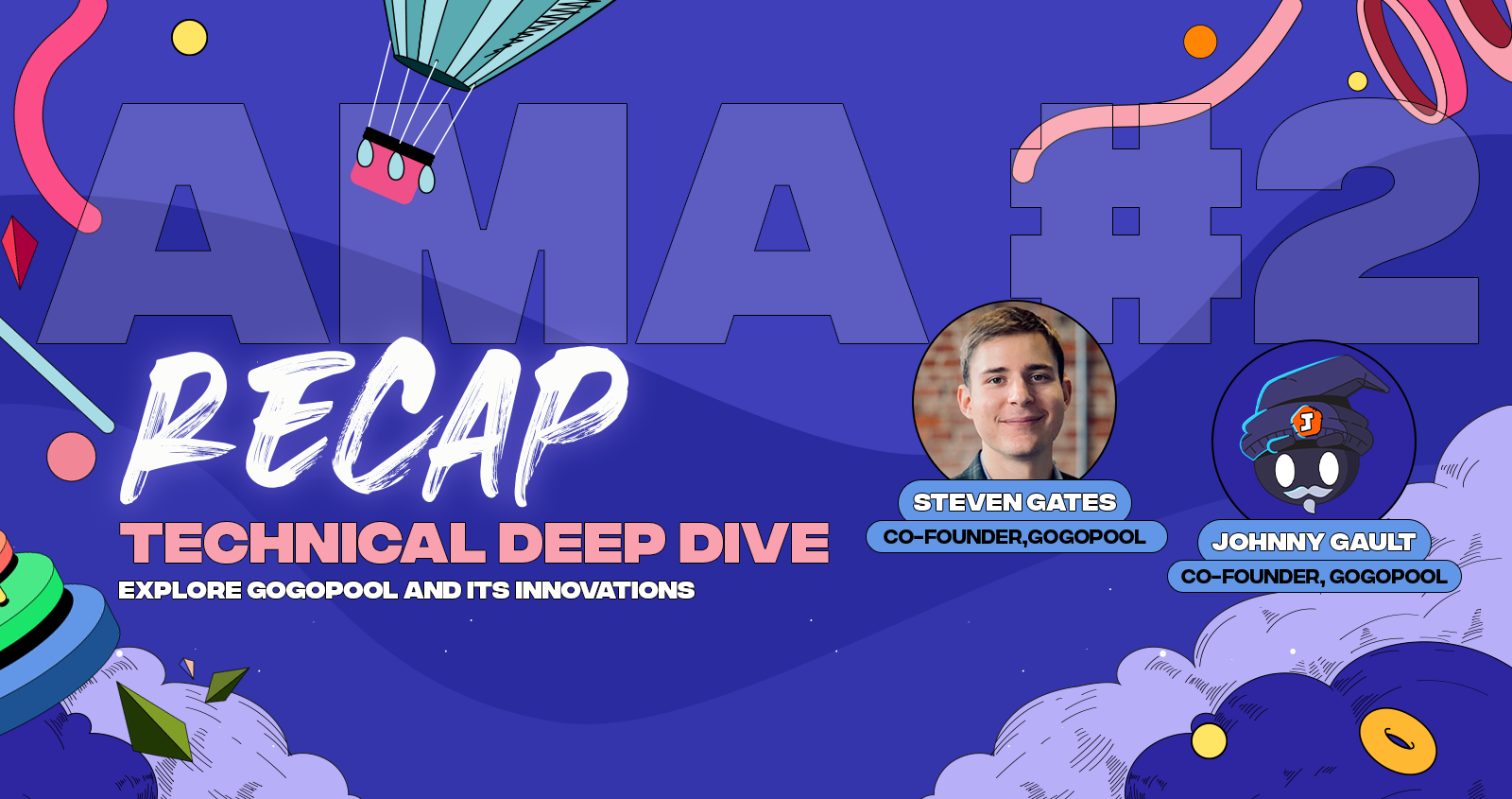

On 4/21/2023 at 1:00 p.m. (PST), an AMA session was held on Avalaunch Telegram group with GoGoPool co-founders, Steven Gates and Johnny Gault, to cover the technical underpinnings of the project. The focus of this AMA will be the underlying tech, development and roadmap.
Below we present to you an excerpt from AMA with questions and answers.
Dave | Avalaunch
Welcome to the follow on AMA with the great GoGoPool. Today we have co-founders @JohnnyGault and @ggp_steven here to trip the lights fantastic. Welcome guys. how are you doing today?
Steven Gates | GoGoPool
Doing great, happy to be back 🙂
and this time with my cofounder, @JohnnyGault !!
who will be joining us for a bit
Dave | Avalaunch
Good to have him as I know we’re technically diving some and Johnny is rumored to be CTO material
Let’s get right into it — Can you describe the technical process for minting and burning ggAVAX tokens in the GoGoPool ecosystem, and how does this mechanism maintain a stable relationship with the underlying staked Avalanche tokens?
Johnny Gault | GoGoPool
ggAvax is an ERC 4626 token that allows for staking rewards to be streamed to holders seamlessly.
Steven Gates | GoGoPool
(and for those technically minded, here is the code 🙂 )
https://github.com/multisig-labs/gogopool/blob/main/contracts/contract/tokens/TokenggAVAX.sol
Dave | Avalaunch
Can you describe the erc 4626 and what that means for the lay person? I think it’s one of the newer standards so I’m not up to speed myself
Johnny Gault | GoGoPool
Its a new standard that allows interop between liquid staking tokens and the rest of DeFi. A standard way for yield to be paid out.
Haha kinda aggressive eh?
Dave | Avalaunch
Understood. We’re finally setting some standards in DeFi 😁
And what is its importance to GoGoPool?
Johnny Gault | GoGoPool
Mainly as a way for our token to be recognized by others in the ecosystem and integrated into their systems and contracts.
Dave | Avalaunch
How have the smart contracts within GoGoPool been adapted to work seamlessly with the Avalanche network?
Steven Gates | GoGoPool
We’ve built the protocol to be a good citizen in the ecosystem and make it extremely easy for others to build on top of.
At the same time, we’ve focused intensely on security and shipping very clean and robust code. As clean and robust as possible.
Dave | Avalaunch
Cleanly and robust. Nice.
How has the decentralized oracle system within GoGoPool been implemented to address the unique challenges of providing accurate and timely data to the platform while operating on the network?
Johnny Gault | GoGoPool
The GoGoPool Oracle DAO will be in charge of running the decentralized protocol that reports price and other information from the P to the C chain. The DAO is invite-only at this time but in the future we plan on using a GoGoPool Subnet for this functionality so that it becomes permissionless, more secure, decentralized, and a public good for the entire ecosystem.
Dave | Avalaunch
This is interesting. This is the kind of project that builds piping beneath the city. Well done
What strategies have you employed to minimize potential slashing penalties in the GoGoPool ecosystem when operating on the Avalanche network, and how are responsibilities shared among node operators?
Johnny Gault | GoGoPool
Risks and rewards are socialized across the entire protocol, so that it is less risky than solo validating or solo delegation. Thankfully, the Avalanche protocol itself makes earning validator rewards pretty easy. So we are not that worried that slashing will become an issue for node operators.
Dave | Avalaunch
Thanks for this Johnny.
What does it means to be socialized across the protocol? Can you say a bit more?
Johnny Gault | GoGoPool
Talking about the ggAVAX staking experience, where there is less risk then say direct deegation.
You are less dependant on a single node for your yield.
As a node operator, yes if you get slashed thats all on you.
Dave | Avalaunch
Got it
Johnny Gault | GoGoPool
But doesnt hurt the ggAVAX holders.
Dave | Avalaunch
Thanks for that additional explanation
What measures have been put in place to handle potential node failures, including redundancy and fault-tolerance mechanisms, to ensure the continuous operation of the GoGoPool network on the Avalanche platform?
Johnny Gault | GoGoPool
We inherit all of that from the Avalanche network itself, when it comes to the smart contracts.
We inherit all of that from the Avalanche network itself, when it comes to the smart contracts.
Dave | Avalaunch
Thanks. Look forward to that.
How does GoGoPool manage upgrades to its smart contracts and other critical components without causing disruptions to the network, and what precautions are taken to ensure smooth transitions when operating on Avalanche?
Steven Gates | GoGoPool
The most important thing for us was security considerations.
Because the Avalanche Network is getting rapid updates, it is important to make sure that the smart contract protocol can update as well to maintain a high degree of security.
In designing the upgradeable aspects, the clear design choice was to focus on mimizing the contagion and minimize permissions for any singular protocol.
Johnny Gault | GoGoPool
As we learn and optimize the protocol, and when the Avalanche protocol supports a few key features, we can “ossify” it and turn it into a permissionless public-good.
Dave | Avalaunch
Excellent. Let’s do one more before we move on to the community portion of the program.
How has GoGoPool’s architecture been designed to adapt to future upgrades and changes in the Avalanche network, and what are the long-term plans for maintaining compatibility and performance as the network evolves?
Johnny Gault | GoGoPool
We are in close communication with core devs, and hope to have a voice (and code!) in the future direction of Avalanche.
The space moves fast, and we can do in jump in and start SWIMMING!
Steven Gates | GoGoPool
The contract system is upgradeable in order to reflect the future upgrades and changes inthe Avalanche nwtork, and like John said —
the intent is to ossify the protocol as the Avalanche updates slow down.
And especially as we think about supporting Subnets!
Community Questions
Dave | Avalaunch
Awesome answer.
Now let’s move on to the community and start with the standard issue softball question…. @Jaeforet36 perhaps predictably asks — Does GoGoPool have any plans to implement AI on its platform?
Steven Gates | GoGoPool
Now THAT
THAT is an interesting question
STAY TUNED!!! !
Johnny Gault | GoGoPool
GoGoPool IS an AI…. sshhhhhh
Steven Gates | GoGoPool
I’m not sure we are allowed to say what is coming next when related to AI
But it is definitely …. how you say …… on our minds.
Dave | Avalaunch
Share something like the alpha machines you are.
Steven Gates | GoGoPool
Let’s just say that a significant amount of Subnets have been interested in AI
And AI will help makes Subnets easy
1 + 1 = 3!!!!
Dave | Avalaunch
Finally, a non-gratuitous potential AI use case. Kudos.
Steven Gates | GoGoPool
🤫🤫🤫🤫🤫
Dave | Avalaunch
And one of the lengthier questions ever asked here comes from @mackfarrow84 who wants to know — I’ve been looking forward to setting up as a validator using GG and I have a question: The docs say that 10% of the avax stake needs to be in GGP tokens, so it’s 1000 avax plus 10% more (but in GGP tokens). So I’m confused as to how many GGP tokens I need to buy in order to run a validator, because the free market is going to dictate the GGP/AVAX price ratio right? Or does the protocol automatically make the trade or something when you setup the validator?
Steven Gates | GoGoPool
GREAT question my friend.
Here is a calculator for you, so you can play around with the protocol numbers:
https://docs.google.com/spreadsheets/d/1Gjdp1rP2MrsGO9QQuia_rjyo_8nQm-5jNDt2vIUZMhI/edit#gid=0
(make a copy + start adjusting numbers ! 🙂 )
Johnny Gault | GoGoPool
But yes for now you have to buy GGP at market (whatever that is)
In the futuer we will make that more seemless.
Steven Gates | GoGoPool
You are allowed to collaterize more than 10%, and earn rewards up to a 150% collaterization.
So if you are wondering how many tokens is needed — the web UI will help guide you through that, and most people tell me that they will just go for a 50%+ collaterization
So that they dont have to worry about the minimum floor.
Dave | Avalaunch
and the good Ernest asks @ErnestBueno18 — what do you foresee as the greatest challenges on your roadmap and given the landscape in Avalanche, your greatest challenge in fully executing on the project’s vision?
Steven Gates | GoGoPool
I think a lot depends on the Subnets that want to build on Avalanche.
And Subnets themselves have their own engineering timelines.
So it is up to us to make sure that building and launching a Subnet is as easy as possible!
And that requires very close coordination with Subnets, the community, and developers in the ecosystem.
Dave | Avalaunch
Although this was addressed earlier to some degree, the incomparable @Amy_springer wants to drill down by asking — is there any documentation regarding slashing for node operators and GoGoPool is a multisig labs project, does this parent company have any other projects ongoing or upcoming?
Steven Gates | GoGoPool
Here are our docs: https://docs.gogopool.com/
A node operators AVAX stake is not slashed. If they have low uptime and lose rewards for the liquid stakers, their GGP collateral is slashed.
GoGoPool started out as a Multisig Labs project, but the GoGoPool Foundation is backing GoGoPool.

GoGoBot at your service… The Foundation is in charge of supporting GoGoPool and the DAO.
Multisig Labs is exploring a second product, geared towareds helping Subnets launch faster. Stay tuned for an announcement on that!
Dave | Avalaunch
Time flies but this is the last one and it comes from the wily @Andromedamin who inquires — Can you explain the benefits and potential drawbacks of using snapshot voting to gauge sentiment in the GoGoPool ProtocolDAO, and how does the Foundation plan to use these results to guide the protocol’s development?
Steven Gates | GoGoPool
Snapshot voting is the first step towards becoming a fully decentralized protocol. It gives the community a way to vote on different issues related to the protocol and to express their sentiment in a clear way.
And that information will guide and Councils that work for the DAO to operate the protocol.
And the Foundation’s mandate is to execute any DAO Action (eg. executing on payroll / HR / legal fees / etc).
And especially, snapshot voting will provide a guide on which grants to fund and not fund.
Anyone can propose a grant (with the purpose of furthering the protocol), snapshot voting can be used to determine if its a go/no go, and the Foundation has the mandate to execute any resulting DAO Action (like payroll).
Dave | Avalaunch
This is very cool. I’ll propose a grant to get on more AMAs
@ggp_steven and @JohnnyGault it was indeed a pleasure having you both here today. I understand that your pre-IDO partnership has received unprecedented interest and will be closing oversubscribed. Well done. It’s nice to see that there’s so much support for what you’re building and we really appreciate your time here today.


